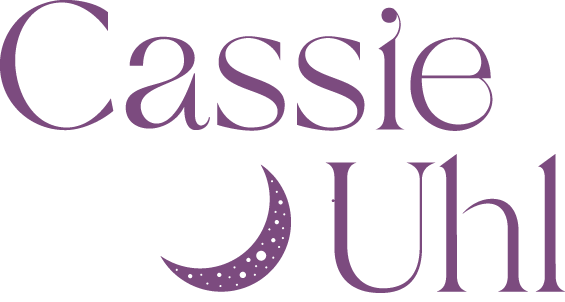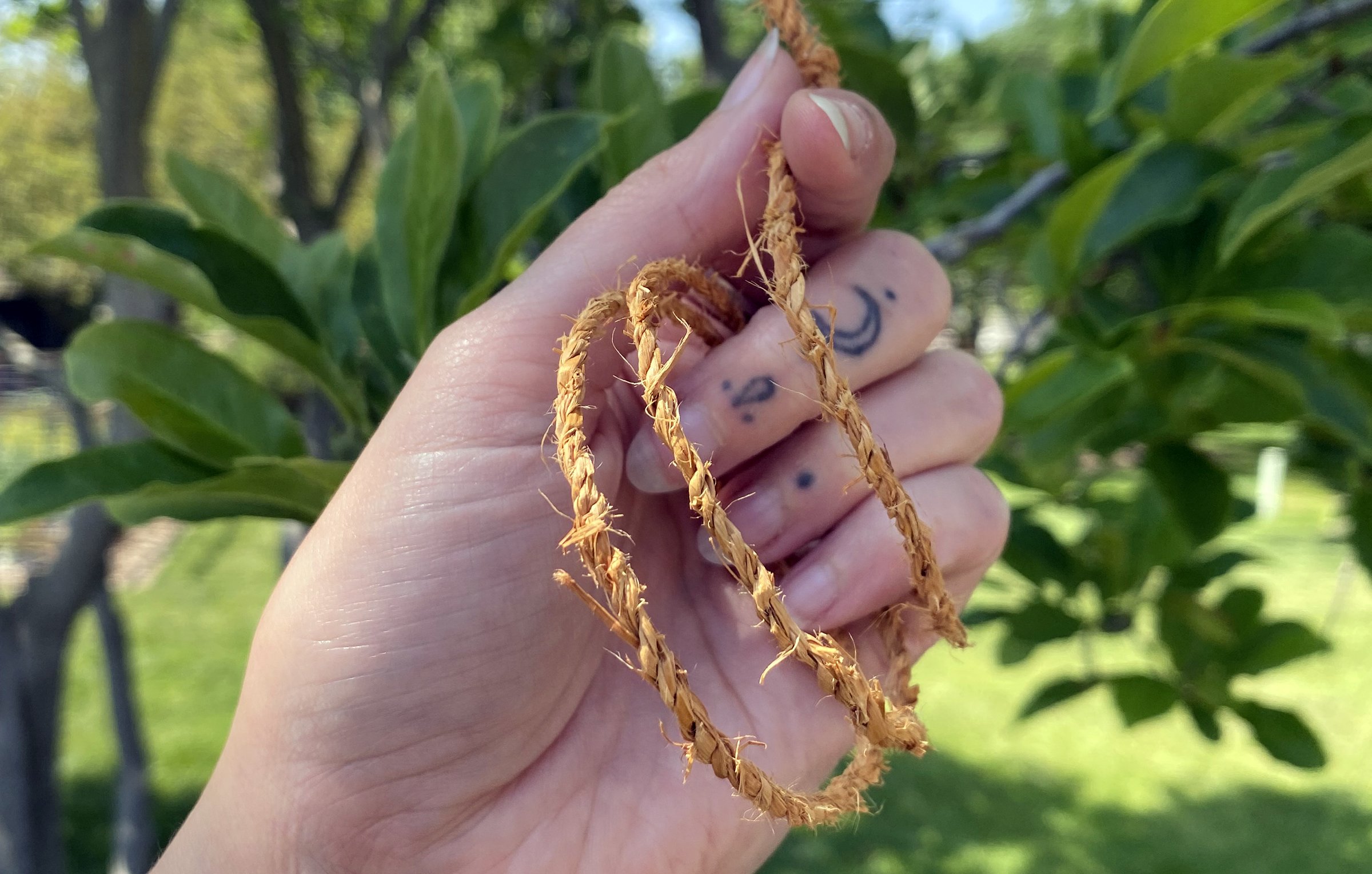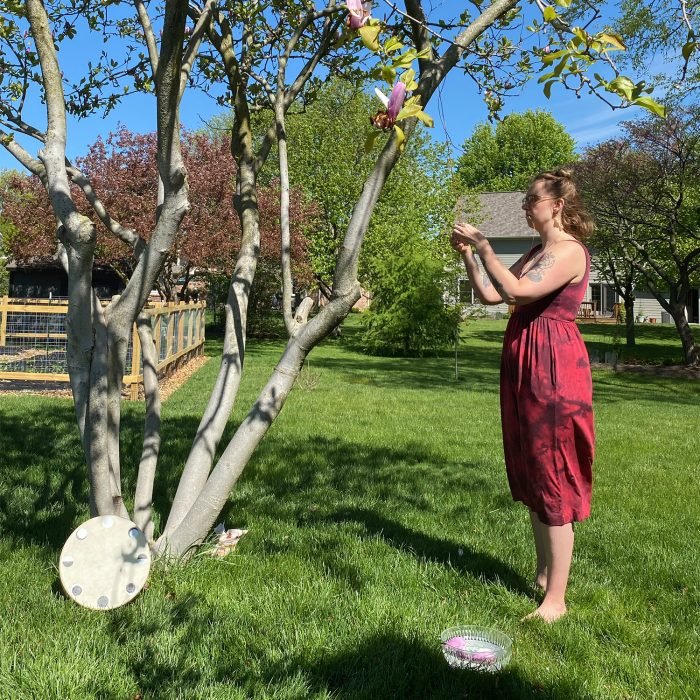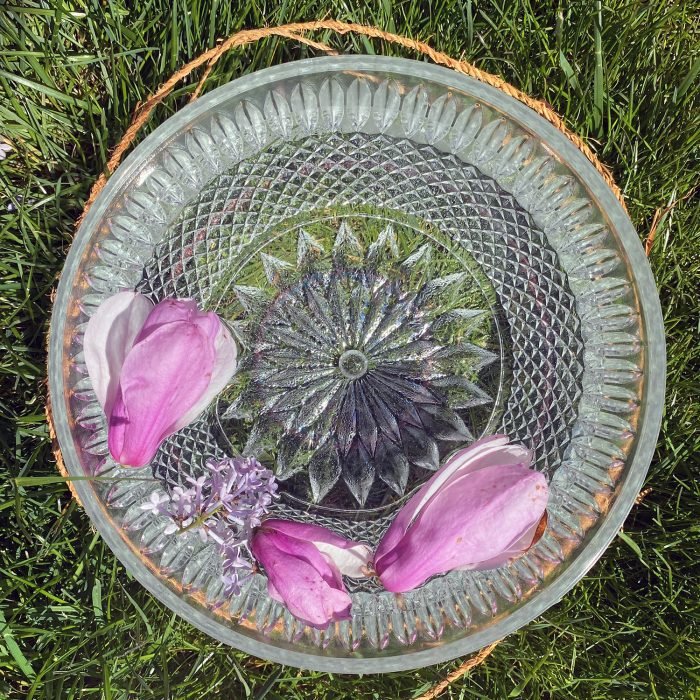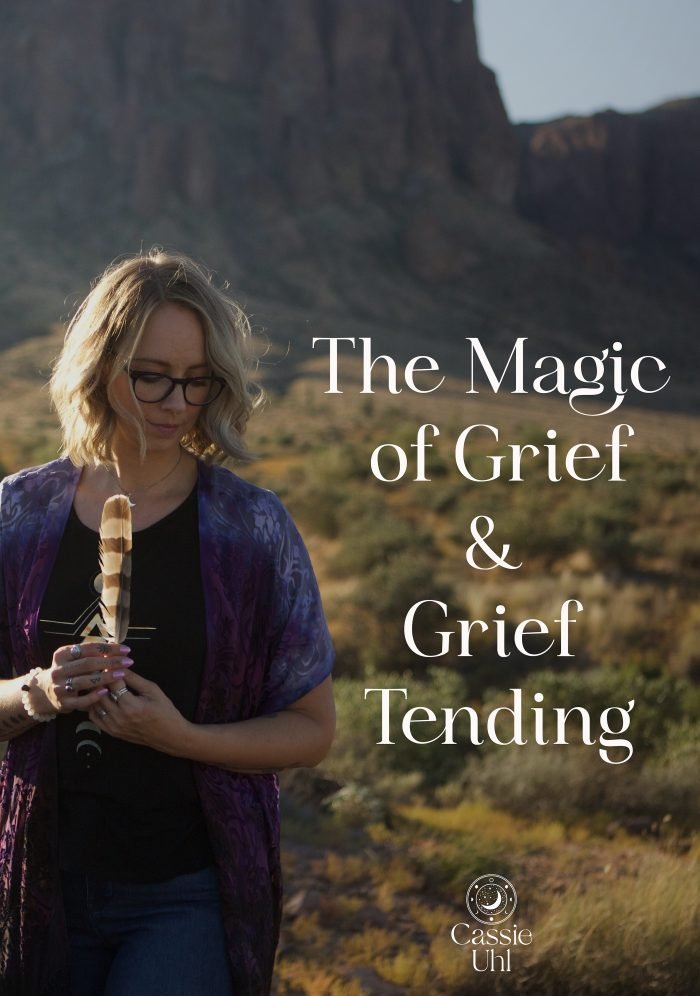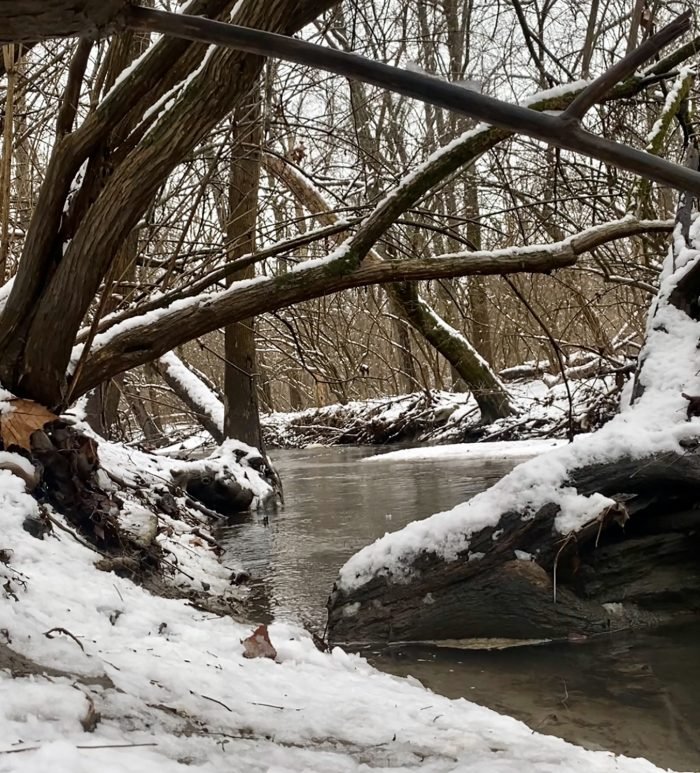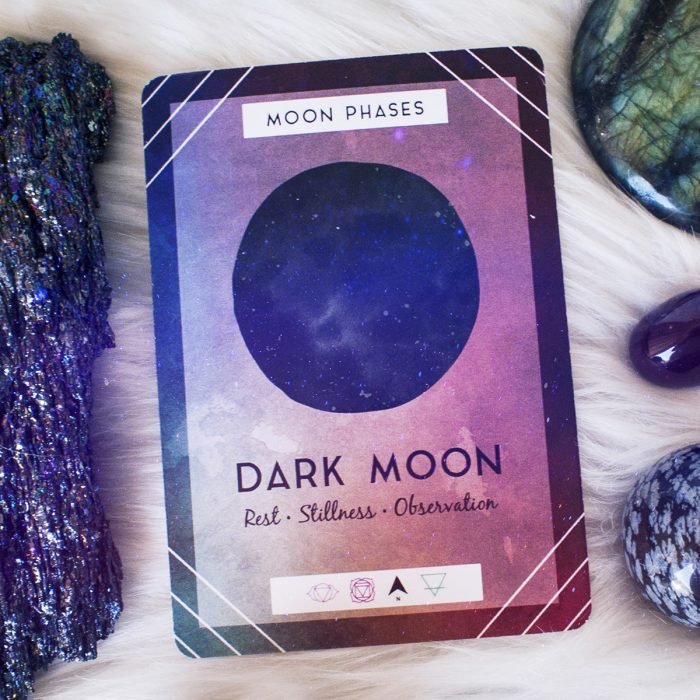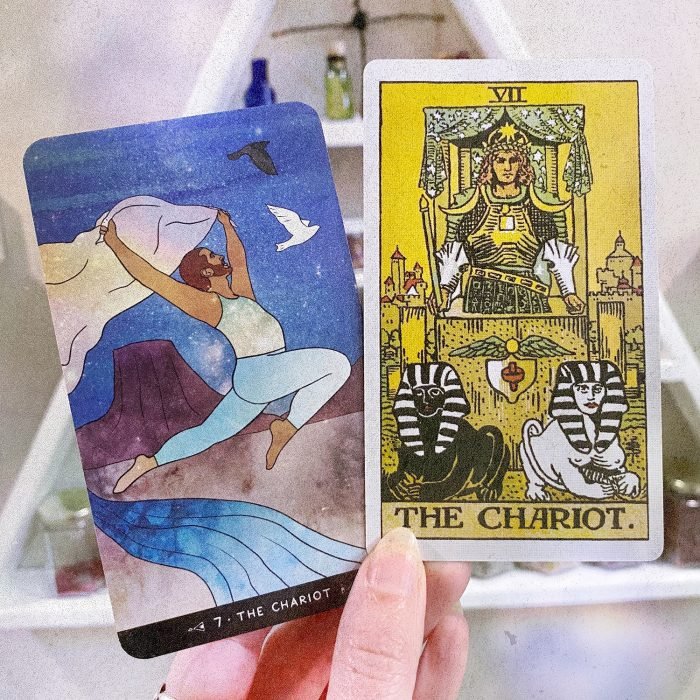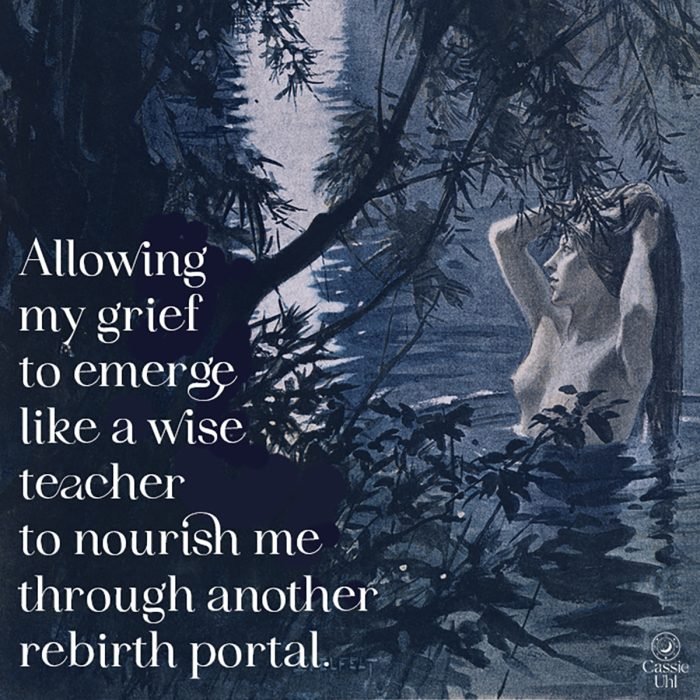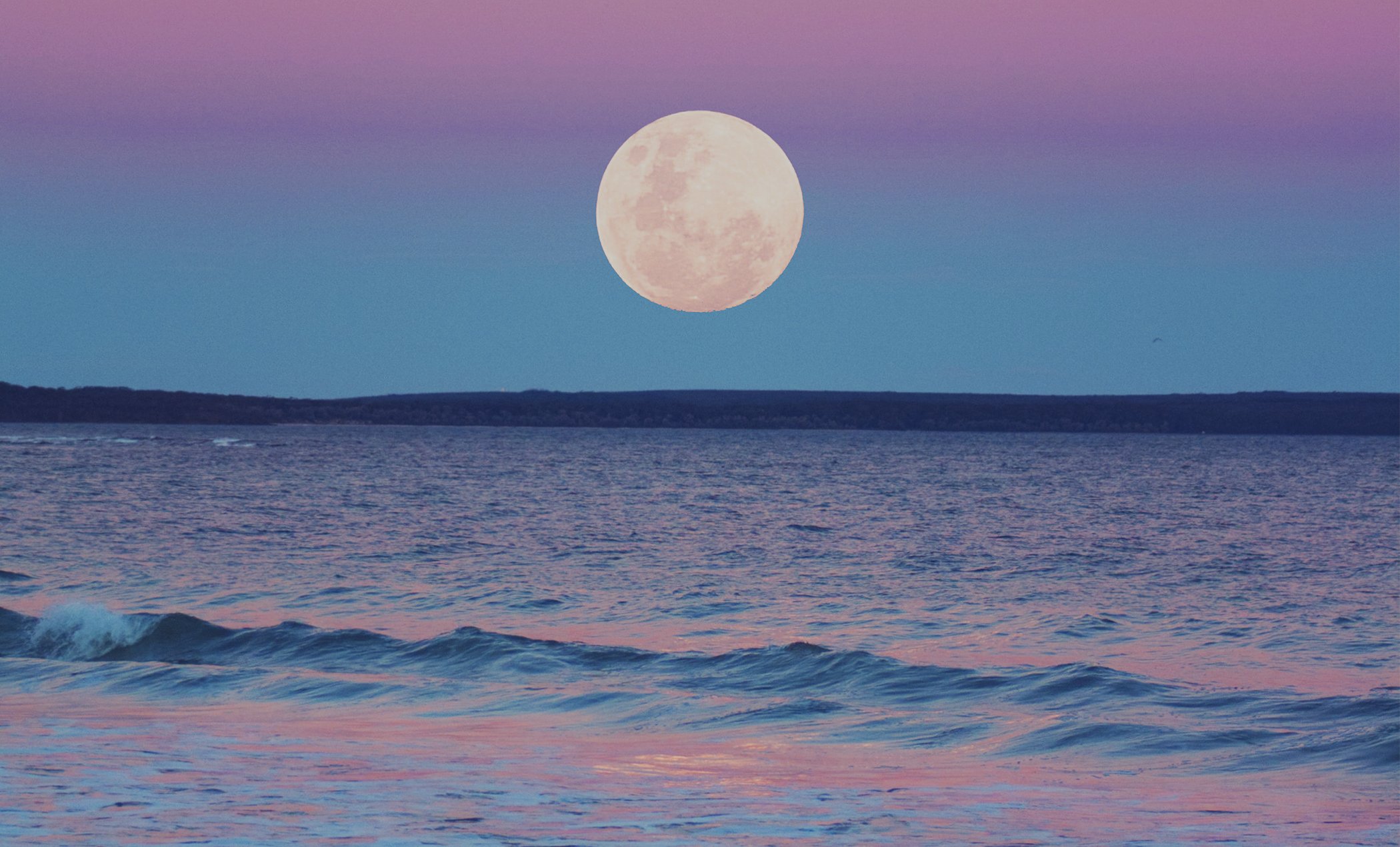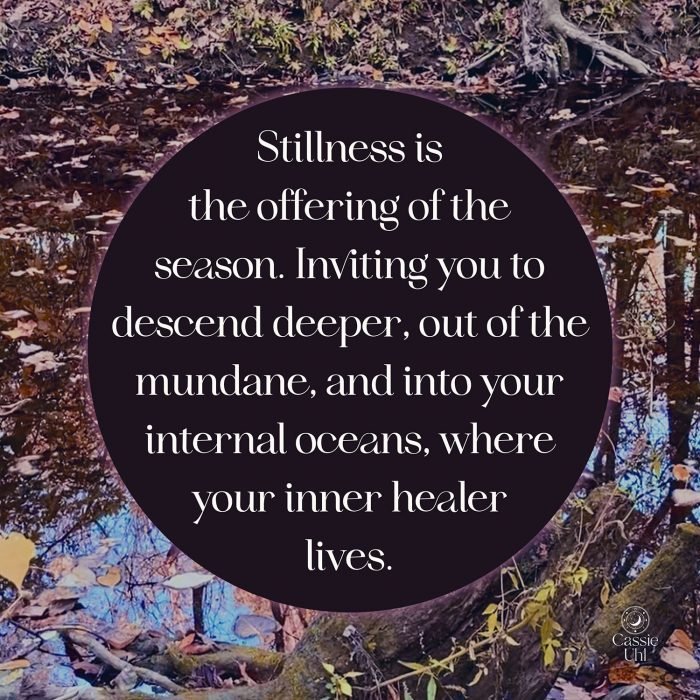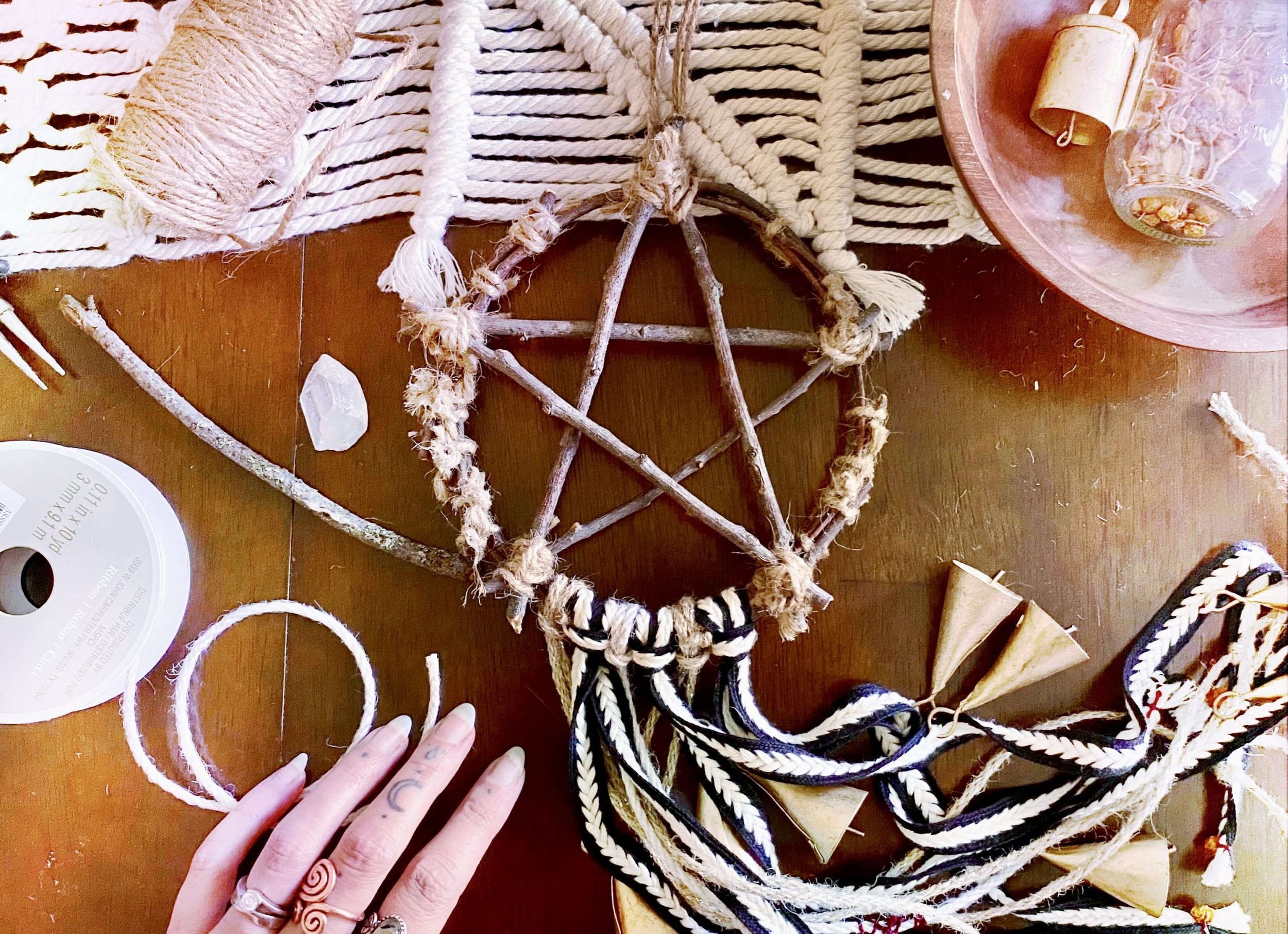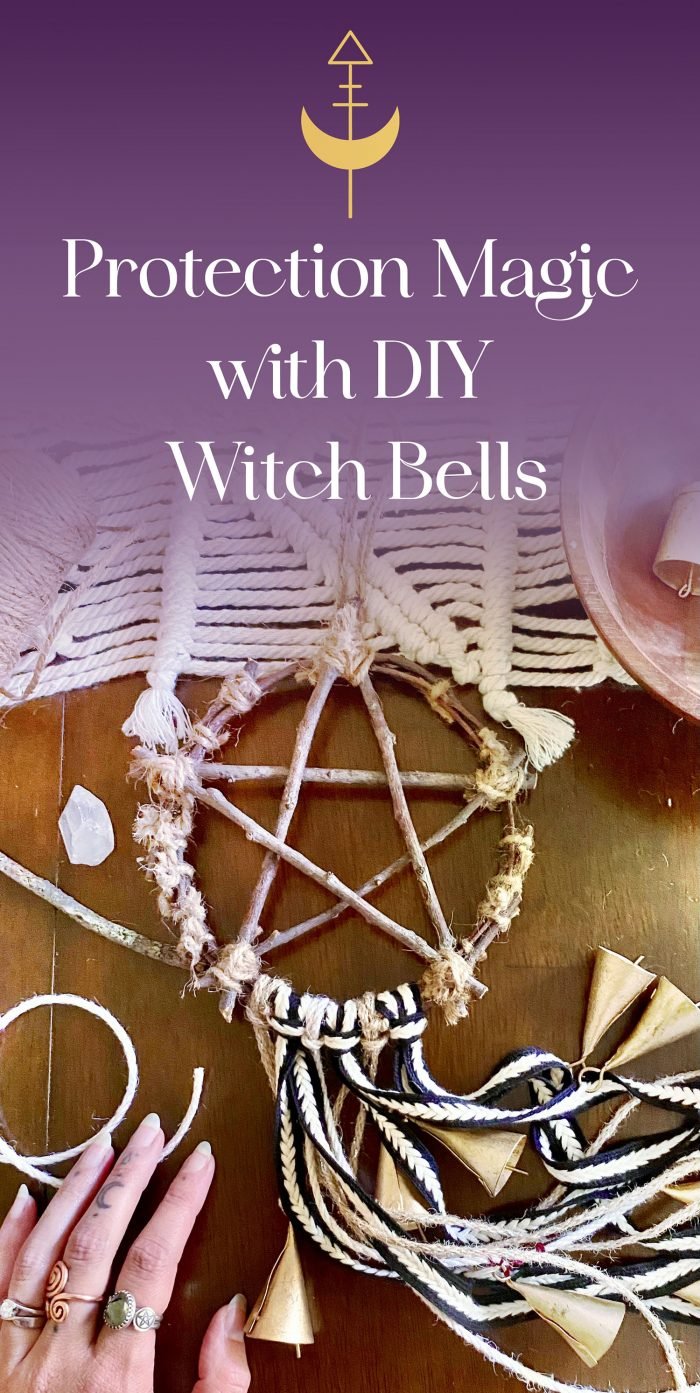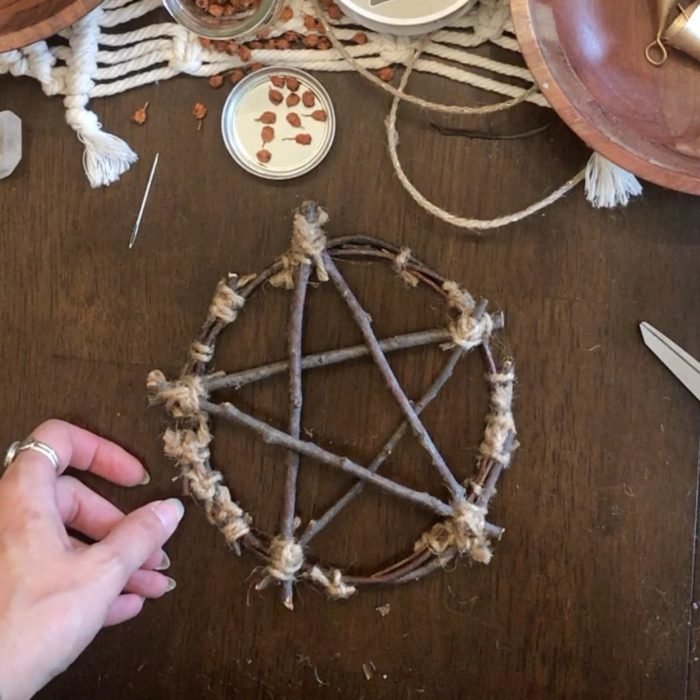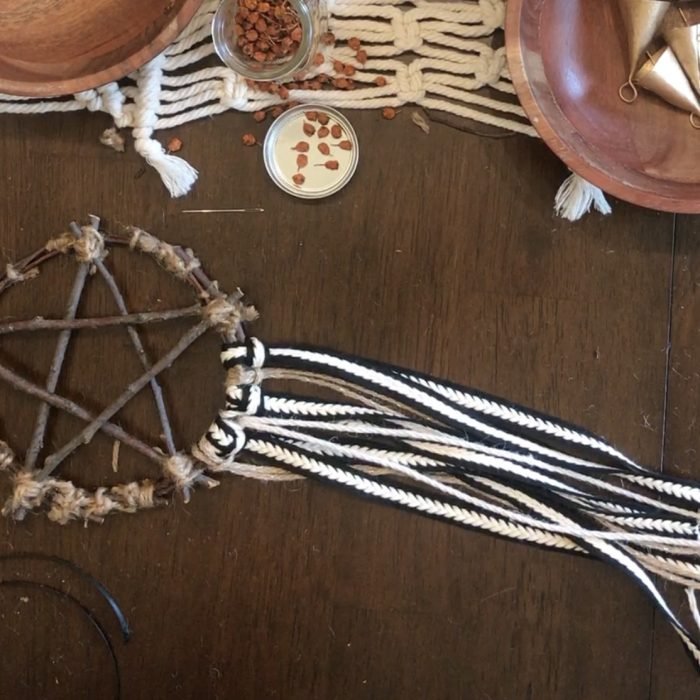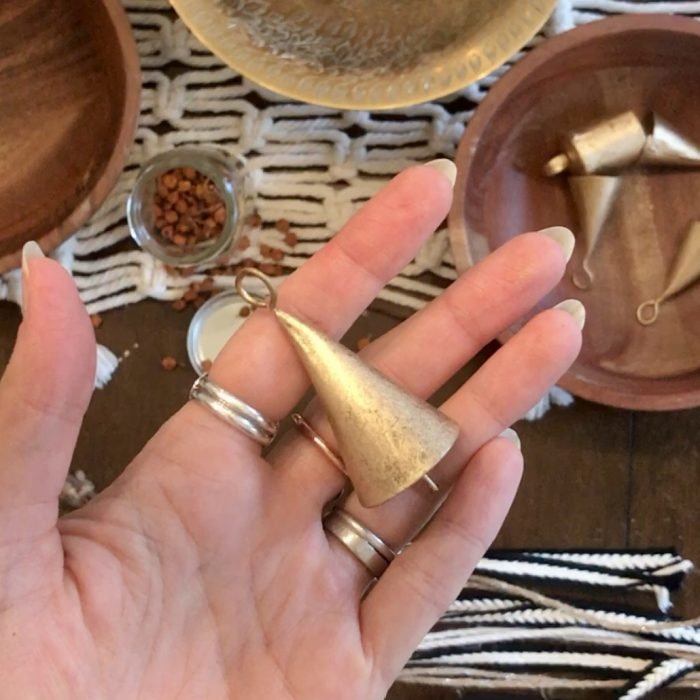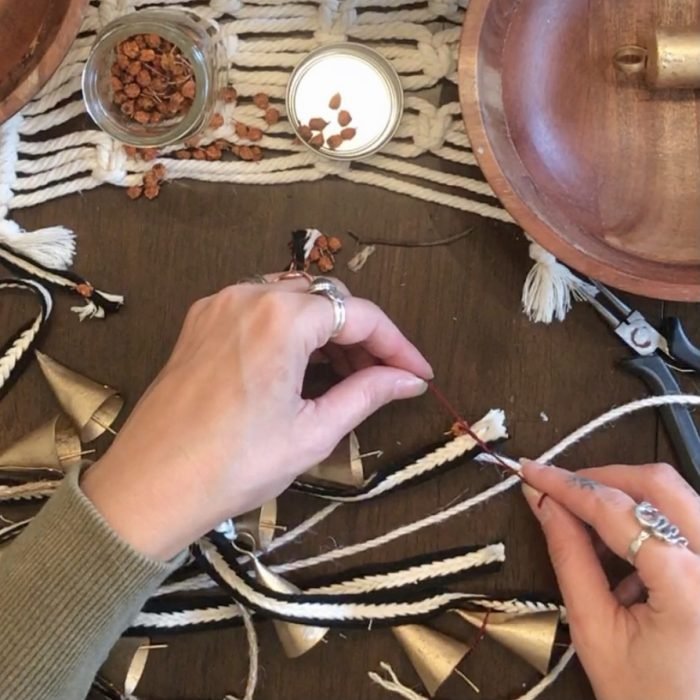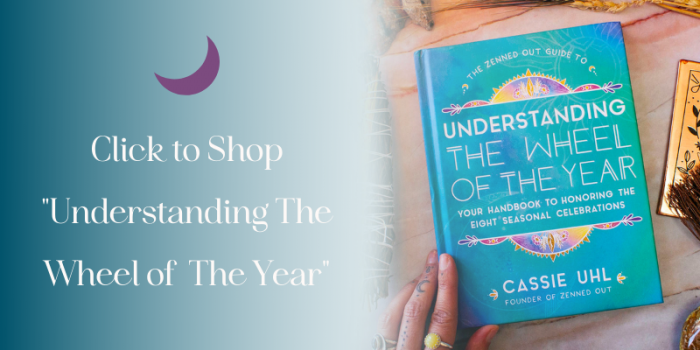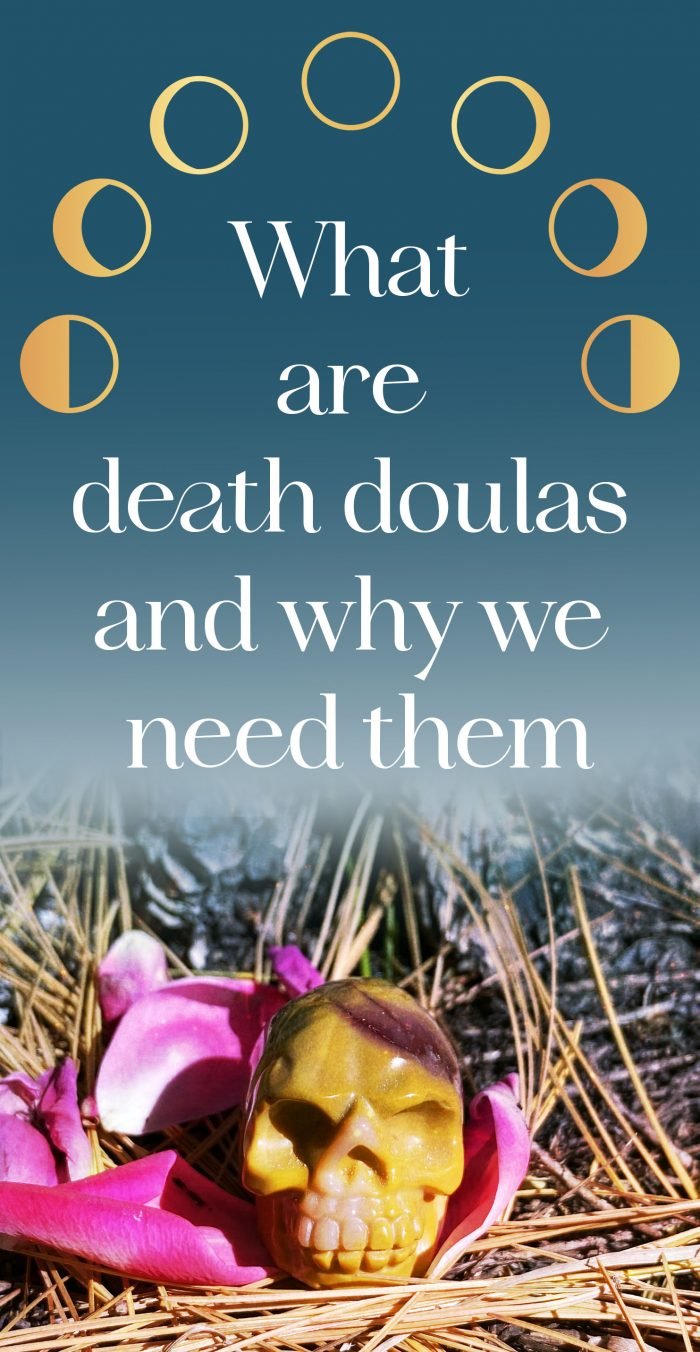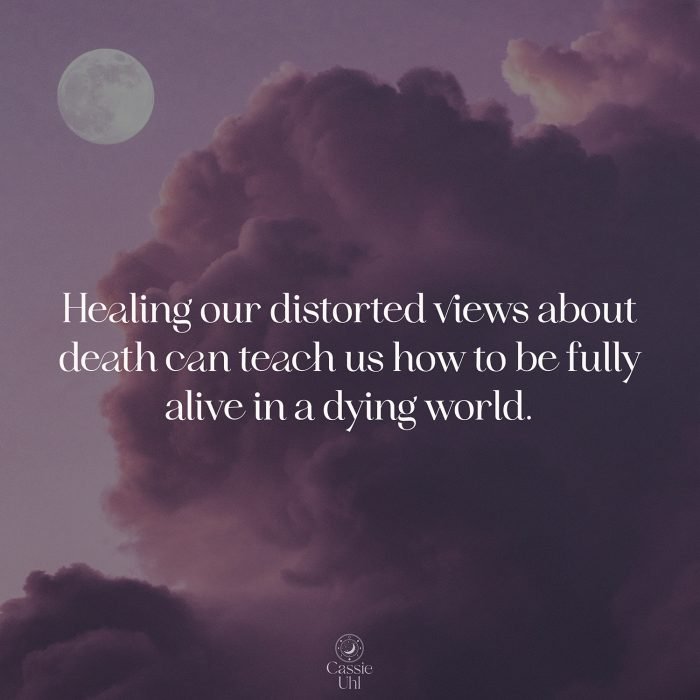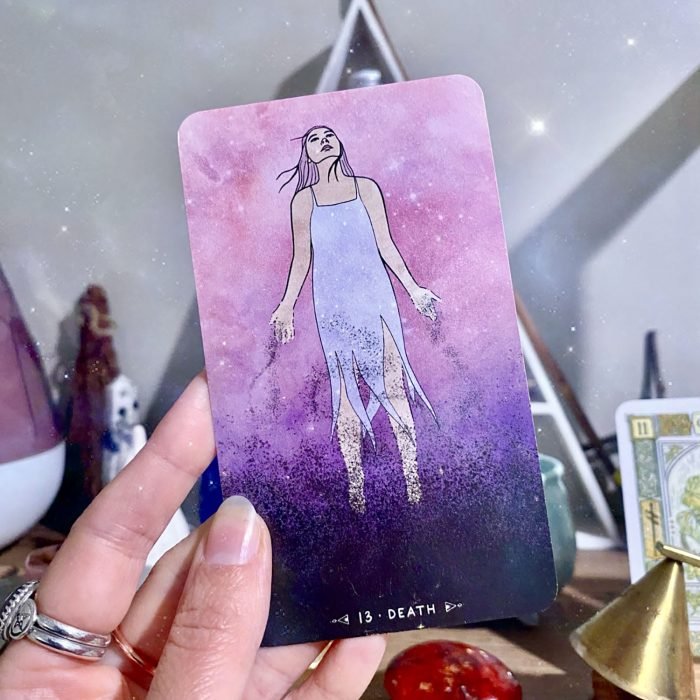A Card Spread for the Winter Solstice
The winter solstice, or Yule, is the year's shortest day and longest night. Yule is a sabbat on the Wheel of the Year that marks midwinter, and even though it’s the darkest time of the whole year, it represents a time of death and rebirth. Here is a card spread to help identify, grieve, and release what’s ready to be shed and reborn within yourself this season.
Weaving Wisdom Past, Present & Future
The Magnolia tree is the oldest flowering tree that we humans know of. Fossils of Magnolia have been found dating back 58 million years. Some botanists think the Magnolia flower, or something resembling it, may have been the first flower on Earth from which all other flowers descended. Magnolia lived amongst the dinosaurs and continues to flourish today in various species. Magnolia is so old that these ancient examples pollinated with the help of beetles rather than bees because bees did not exist. It has witnessed many of Earth’s phases, expansive, destructive, regenerative, and everything in between.
The Magnolia tree is the oldest flowering tree that we humans know of. Fossils of Magnolia have been found dating back 58 million years. Some botanists think the Magnolia flower, or something resembling it, may have been the first flower on Earth from which all other flowers descended. Magnolia lived amongst the dinosaurs and continues to flourish today in various species. Magnolia is so old that these ancient examples pollinated with the help of beetles rather than bees because bees did not exist. It has witnessed many of Earth’s phases, expansive, destructive, regenerative, and everything in between.
A beautiful Magnolia tree, Magnolia X soulangeana, often called Tulip or Saucer Magnolia, lives next to our house. It was quick to get my attention upon moving here last year. When Spring came, it flowered early, as many Magnolias do, and let me know it was time to weave some magic. The early bloom of Magnolia is something else I find interesting about these trees: they often flower early, losing blooms to inevitable cold snaps, yet, Magnolia continues to thrive.
Magnolia X soulangeana bloom.
How Magnolia and I would work together was still unclear in the early Spring. I’ve learned to allow these things to unfold in their own time. As I continued to connect with Magnolia, both in person and in journey, guidance and direction began to take shape. Others were invited in, Grandmother Cedar and Lilac Tree, so, I began connecting with them too. I’m increasingly taken by the force at which some magical workings move me into actions I do not always fully understand. I now know this to be where the most potent magical workings happen. When I release control around what magic I think is needed, I open myself to the energy currents around me and the wisdom of other beings and spirits I’ve come to trust. I can be an instrument for needed magic to take shape without my human influence, inserting myself as a more communal part of both the physical and non-physical realms. I am simultaneously an integral and insignificant part of the magical workings, as I trust another would bring it to life if I did not.
Throughout this process, I learned how to weave a cord from the inner bark of Cedar and crafted a beautiful three-strand rope as part of this collaboration. I am quite proud of it! Further guidance suggested combining these tree energies in a vibrational or flower essence. However, the water worked with in this process holds more than the flowers placed atop it as there was quite a bit unfolding around it at its inception.
Grandmother Cedar tree and her inner bark used for the rope.
As my practice deepens, I’ve become more aware of collective energy shifts and often feel a need to help midwife energies in or out of the collective. Sometimes, I sense these shifts in small groups of people, the country, or humanity. This was one of those times and felt like the latter. Though Magnolia tipped me off to this project months earlier, these workings culminated during an eclipse season. Which, if you know, you know. Right? Most of this last eclipse season felt like a trance-like blur. Perhaps, for you too?
This collaborative creation was a midwifing in situation, a remembering. Magnolia’s easeful wisdom reminded me that we have access to the same timelines they do. Like Magnolia, we can weave back into the past by connecting with the parts of ourselves that lived in various parts of the world hundreds and thousands of years ago. It’s all there in our blood, bones, and the dirt beneath us that grows our food. As is the future. Magnolia showed me time as an accordion-like shape that can fold in on itself and expand, as though time is simultaneously linear and singular. A feature that enables us to access different points at will, inviting us to lean on the perseverance and wisdom from our past well and healed ancestors and the strength and desires of our future well and healed descendants. Beyond different timelines, I was also invited to explore different parts of my personal timeline for healing, strength, wisdom, and hope. For example, accessing the healed and whole maiden bursting with playful curiosity and desire when needed, knowing I can also access the wise crone who may or may not be fully realized physically yet lives within me now.
The invitation I found in this experience was to become more comfortable navigating and seeking support and guidance from these different timelines, both within myself and the collective. Working in this way felt more like a remembrance than a new practice. It also helped expand the depth of my otherworld support network in ways I didn’t know I needed, which helped me navigate the unfolding present. I think most of us, especially magical and spiritual folk, sense significant changes on the horizon. Our desires as a collective, alongside our plant and animal kin, feel like they’re culminating. Albeit outwardly and by design, it may not appear that most of us have the same overall desires, I believe our desires are more similar than we’re led to believe. Seeds are planted, and it seems all timelines seek to support a bountiful harvest that supports all life beyond humans.
But these transitional times can be messy, confusing, and scary. Our metaphorical growing season may bring pests, drought, or uncertain situations. Messy isn’t bad, but it often requires additional resources to navigate the frequent reorientations needed to move through it. Magnolia impressed upon me some solutions, a remembrance of our ability to weave together the wise and healed ones of the past, present, and future. We need to expand our perspective far beyond the perceived challenges of these times by leaning on the wisdom of the past and future well and healed ones. Well-rooted strength, hope, and love are waiting for you in different timelines, and they are excitedly watching, ready to assist, as are the different versions of yourself.
If you’re reading this, I doubt this is surprising. I suspect it’s information that will feel like a confirmation because it’s energy you’ve also picked up on. We’re in for significant changes here on Earth, but I feel well-resourced and equipped for whatever comes. And, when I don’t, which is also often, I remember that I have the support of the wise ones in all timelines guiding me.
Chanting and weaving the Cedar rope as the essence steeped.
I chanted as I wove the cedar cord over the steeping essence of Magnolia and Lilac flowers, “Wise ones, maidens, mothers, and crones—healed and whole. Past, present, future, weaving together the here and now.” or some variation of it. The essence is bottled, with a portion of the Cedar cord around each bottle, and titled the Wisdom Weaver Elixir. It feels important, but it also feels like the waves of the work are rippling out regardless of who consumes the essence. I do like it, though, and it feels like some of the most meaningful magic I’ve been a part of.
The essence with Lilac & Magnolia flowers & the finished Cedar rope around the glass.
A personal result of accessing these timelines is that I’ve been connecting with a second-generation successor of my children. It’s been inspiring and exciting as most of my spiritual connections have revolved around ancestors and otherworld beings. Connecting with this related being from the future grants me a hopeful and beautiful perspective. Your ancestors have walked through much, as have you and the lineages beyond you who will inhabit this realm, or are already. I’ve certainly enjoyed expanding my community beyond the present by allowing it to weave through different timelines within myself and beyond. Perhaps we’ll need more than ourselves to dance through this phase.
The Magic of Grief & Grief Tending
Every rite of passage and rebirth you experience, whether on a spiritual, emotional, physical, personal, or collective level, includes opportunities to grieve. Yet, talk of grief is often reserved for death and dying alone. While in truth, grief relates to any deep sorrow, and sorrow accompanies many of the rites of passage we walk through. Some of the rites of passage, rebirths, and deaths that come to mind that so often lack our grief are the onset of menstruation, puberty, childbirth, monetary changes, loss of friendships, moving, changes in important relationships, career or work changes, deaths, and collective changes like climate change and the pandemic, just to name a few.
Every rite of passage and rebirth you experience, whether on a spiritual, emotional, physical, personal, or collective level, includes opportunities to grieve. Yet, talk of grief is often reserved for death and dying alone. While in truth, grief relates to any deep sorrow, and sorrow accompanies many of the rites of passage we walk through. Some of the rites of passage, rebirths, and deaths that come to mind that so often lack our grief are the onset of menstruation, puberty, childbirth, monetary changes, loss of friendships, moving, changes in important relationships, career or work changes, deaths, and collective changes like climate change and the pandemic, just to name a few.
Listen to this post on my podcast, Rooting into Wholeness, here.
Grief lives within every death and rebirth cycle, waiting for us like a wise teacher ready to help us alchemize through another right-of-passage portal. Unfortunately, for many of us, rights of passage are sorely lacking in our personal lives and collectively, leaving our ability to properly grieve important changes neglected. How might our view of grief and grieving change if we could hold these words with more reverence? How would life's rights of passage, death, and rebirth processes look and feel if you had more time and space to grieve them properly? How might we as a collective find more peace if we made more space for the magic of grief?
In the book Death Nesting by Anne-Marie Keppel, she shares this about grief, "Rather than seeing it as something to "get through” and "move on" from, learn how these new feelings incorporate into your life. Death changes life–that's what it does. Be gentle with yourself and others as you learn this new being you are becoming." When I grieve, I'm often reminded that I need far more time and space than I think to be with my grief. What would happen if you allowed more time to tend to your grief or, as Anne-Marie put it, “to learn this new being you are becoming”? Would you turn into a pile of tears, incapable of moving forward? Maybe for a little while, but not forever. I suspect your grief, like mine, has wisdom, healing, and even inspiration to offer you as you navigate this physical world. Perhaps focusing on our grief is the transformative and paradoxical magic we need to emerge from personal and collective rites of passage more healed and whole.
This isn't to say grief tending is easy, and of course, there are barriers to regular grief tending embedded in the systems in which we live, so each person's ability to grieve will vary. The natural cycles of nature and the moon show us ways to grieve even when it may be difficult. I've found in my own grief tending that my ability to grieve directly correlates to my capacity to love myself and others and experience deep joy. Like most things, the more time you spend cozying up to grief, the more natural it will feel over time.
Like so many areas of life, perhaps the best place to better learn how to grieve is by turning to our closest teachers in the natural cycles surrounding us, like the moon and the seasons. In this share, I'll explore grief through the seasons, moon phases, and the tarot, gleaning ways to honor and learn from our grief to help us become whole and more firmly rooted in our humanness. I'll offer energetic insights into how I see grief show up in the energy body as an energy worker, how I approach it on an energetic level, and other grief rituals. This share is an invitation to examine your grief, and the magic, healing, and joy found within the grieving process.
As a human who grieves, a death doula, and an energy worker, I'm no stranger to grief, but I'm also not the authority on grief. As a cis white woman, I carry internal biases that skew my perspective, which undoubtedly pertain to my experiences around grief. As always, take what you like and leave the rest. Furthermore, if you've recently lost someone or are experiencing deep grief, I invite you to be gentle with yourself as you listen and take breaks if you need. Therapy can be a wonderful ally to grieving. You don't need to do this alone.
Grief and the season of slowness, winter
Wintertime is our dark moon of the year and a palpable reminder of the need for slowness, darkness, death, and the need to retreat inward. The hibernating flora and fauna remind us not to extend our energy outward year-round. Inward and descending energy has a vital and nourishing role in our existence. My son wisely described this season as the time that "the sun takes a rest." As I write this, here in the Northern Hemisphere, we are a week away from the Spring Equinox, positioned on the cusp of the season of rebirth. For me, the grief is palpable.
As my first year back in a cloudy, cold climate for winter, it dawned on me that the seasonal depression I felt creeping in was another metaphorical red flashing sign inviting me to "slow down!". Leaving me wondering, would the effects of SAD be as bad if I could rest and retreat inward even more throughout the winter months? The amount of sunlight we have access to throughout winter may be fixed, but the reality is that slowing down, regardless of the season, is simply not an option for most. Depression is real, and lack of sunlight can certainly play a role, but would SAD be as severe if people could slow down and grieve more amidst these natural seasons of less light?
A view from one of my many midwestern winter season walks.
When I lost my grandmother and father within a couple of months of each other, I entered what I like to call a "grief portal." Time seemed to slow down, everything felt hard, and through my patriarchalized and capitalized lens, I just wanted to return to "normal." The biggest lesson I took away from that experience was how much slowness my grief required. I needed loads of time to do nothing to allow things to process. Of course, the way each person processes their grief will be unique, but for me, getting to a place where my grief can come out to be processed requires tremendous slowness.
Of course, rest and slowness may sound lovely, but there are very real barriers to this kind of big rest, grief tending, and inner transformations. I was privileged to have the space to slow down amidst my grief amidst deep loss. Having time for big slowdowns to process grief may not always be doable. Add to these barriers the fact that many of us have endured various levels of conditioning to place more value on our ability to produce over our ability to simply be. Slowing down can feel like a life-and-death situation. Yet, for many of us, this is what grief needs.
It is within this season of slowing down and integrating that our grief wants to be witnessed and held close the most. The world outside is in a literal death phase, reminding us daily to honor our personal need to grieve. Yet, our attempts to make space for grief can, understandably, feel too difficult to make space for or thwarted due to the demands of living in a capitalist society, stretching us ever thinner in a time when we should have the space to be with our grief and let parts of ourselves die away.
Returning to the midwest and communing with the winter landscape has left me pondering how to rewrite this season to make more space for my need to grieve, integrate, and transform. I'm learning that being with my grief at this time is the most potent spell and healing gift I can offer myself this season. When the inevitable happens, and my grief bubbles up, or someone else's grief begins to overflow in my presence, I try witnessing it without judging it or trying to fix it and instead, asking myself how to lovingly hold the space for it, allowing it to be witnessed just like the death of nature all around me. What a powerful gift for myself and others when I can approach grief from this tender and vulnerable space.
When I look at grieving as something I need to thrive and become whole, it feels less like something I need to get over and more like something I need to hold dear. When I move further into being present with my grief, its magic shines even more. My ability to be present with more grief and the grief of others expands, and my grief transforms into the gift of being present for someone else in their grief. I found myself sitting with the starkness of the winter landscape, witnessing the grief of nature on full display, and wondered if, rather than tucking grief neatly away for an "appropriate" time, perhaps we could be like the winter landscape and allow our grief to simply be.
Of course, wintertime is not our only season of grief, death, and rebirth. Mother moon shows us how to die, grieve, and be reborn every lunar cycle. Let's explore the wisdom of the dark moon phase in relation to grief.
Honoring the dark moon
The dark moon phase is mother moon's death, rest, and integration season. Unlike the full moon's magic, the dark moon is not a time for manifesting and materializing but for returning to the inner cauldron, shadow work, and connecting with unseen realms. It is a monthly opportunity to honor death and grief.
Dark Moon card featured from The Ritual Deck (discontinued)
In Sarah Faith Gottesdeiner's book The Moon Book, she describes the dark moon as "a site of liberation," and I couldn't agree more. It is within the darkness of this phase that we are granted the space to excavate from our depths the parts of us that need to be witnessed and loved the most. By loving these parts of ourselves and witnessing our grief, they can be fully integrated into our inner soil, cultivating a necessary richness for new seeds to be sown.
When I neglect this phase of the moon's cycles, my inner earth remains parched, thirsty for my grief to be witnessed and tended. Liberation comes when I can hold my sorrow close, rock it, and tell it it's okay to be. Giving my grief permission to integrate into my inner landscape gives rise to the fertile soil needed for new life. I get free.
The beauty of honoring grief through the dark moon phase is that it comes every month. You don't have to grieve everything at once. The moon reminds us daily that we're not fixed beings and that change is our true nature. We are not meant to be radiant and positive every day; we are also not meant to grieve every day. Every lunation is an invitation to honor where you're at and how you feel, not how society tells you to feel. The dark moon is often the reminder I need to honor my grief and the little day-to-day deaths we all experience. Sometimes, we're intended to crumble and be held by the earth, and the dark moon phase can be a monthly ally to assist in this kind of grief tending.
Grief as paradox and the chariot
Beyond my personal grief tending this season, I’ve noticed the topic of grief surfacing more on a collective level as well. Have you noticed this, too? Being in a chariot year (2+0+2+3=7, which corresponds to the chariot), I found myself called to think about grief in relation to this card and was excited to see so many overlapping themes and invitations around grief and grieving. Even though the chariot is not usually correlated with grief, I think it has some wisdom for us in this collective season.
The first clue to the chariot card being an invitation to help us grieve is its placement, and I’ll be honest, the placement of this card did not dawn on me immediately. It wasn’t until I was in the final editing process of this share that I received a little nudge reminding me that the chariot card is the last card of the first line in the major arcana. Wow. Talk about an opportunity to invite grief in. The placement alone sets this card apart as a point of death and rebirth. The fact that the chariot card is the card associated with 2023 indicates that this is indeed a year to, among other things, honor our grief individually and collectively.
Left: The Chariot Card from Journey Tarot by Cassie Uhl, Right: The Chariot Card from the Waite/Coleman deck
This isn’t the only invitation to grieve that I’ve found in the chariot. The chariot card is one of those cards in the major arcana that I find has many layers, paradoxes, and can mean different things at different times of life. Let’s dive into the paradox of this card and how it shines a light on the paradox in grief.
The name of the chariot indicates movement and action, yet, on the Waite/Coleman deck, there is no movement shown. It is often touted as a card of willpower yet corresponds with the soft and intuitive energy of Cancer in the zodiac. The paradox continues with the duality of symbology, which can be seen in the black-and-white sphinx looking in different directions. I captured this in my deck with the black and white birds heading in different directions. The medicine of this card is potent and not one that I will be able to fully expand upon here, but I think it has some powerful invitations for us as we examine our grief on a collective level.
There’s a certain amount of resiliency building that accompanies regular grief tending. This is where the chariot comes in. Within the chariot's many layers, there are elements of softness, which we can see with the Cancerian energy tied to this card. There is an invitation to allow what is, to sink into it, and to try to be in a state of flow with what is, even when it’s uncomfortable.
I see the willpower part of this card come in with how we engage with emotions and grief. The chariot asks us to allow a steady stream of emotions to flow, all while staying on course or perhaps being open to flowing in a new direction. With the gates of grief open, your emotions may indeed put you on a new course entirely or direct your life in new ways. The chariot can be an invitation to get more comfortable in the ups and downs of grief tending. It shares possible avenues to explore around building resiliency while pendulating between grief and joy. Asking, “how can we be with the joy and the grief without being knocked off course so far that we can’t come back?” or, “how can we allow the pendulation between grief and joy to carve a new pathway?”
There’s a certain tension held within the chariot card—a tension between the world of our subconscious emotions and the logical world. In Rachel Pollack’s book Seventy-Eight Degrees of Wisdom, she expresses the tension found in the chariot through our relationship with speech and language in this excerpt. “However, just as the ego is limited, so is speech. First of all, speech restricts our experience of reality. By forming a description of the world, by giving everything a label, we erect a barrier between ourselves and the experience. When we look at a tree, we do not feel the impact of a living organism; rather we think ‘tree’ and move on. The label has replaced the thing itself. Also, by relying too much on this rational quality of language we ignore experiences that cannot be expressed in words.”
In what ways do we limit our ability to feel our grief fully and all of the magic it has to offer? Cancer, the astrological sign connected to this card, epitomizes feeling and being in our emotions. When paired with the strength and willpower of this card, how are we being asked to use those emotions to direct our movement forward? There is an over-arching theme of being in flow with the discomfort of not knowing where our emotions will take us, which may be another reason some fear sinking deeply into grief. I know I’ve certainly held this fear. What would it look like if the tension between your emotional and logical worlds were in harmony? How might inviting more grief into your daily life inform your daily actions or larger goals?
This plays out in so many ways societally as well. I find myself constantly faced with the paradox of seeing and experiencing deep pain and injustices in the world, yet, I’m asked to forge ahead like everything is okay, or worse, that it’s completely normal to shove these grievances under the rug and carry on. I think intuitively, even humanely, many of us see how problematic this is. This is certainly one side of the chariot, the idea of forcing and forging ahead at all costs by leaning deeply into our willpower. But, if I invite in more of the nuance this card offers, I can see the need to bring my emotional and subconscious world into my decision-making and how I use my energy. Through this lens, I can see the chariot as an invitation to lean into my willpower to find ways to dance between and betwixt my emotions and the logical world.
How might our trajectory as a collective change if more of us were forging new paths by flowing between our emotional/subconscious and logical/physical worlds? I sense this shift coming as many of us tire of binary thinking, especially in political spaces. These shifts could be slow and painful, but I don’t think they have to be. There’s so much space for deep joy and pleasure in these in-between spaces around our grief, joy, and the real demands of day-to-day life. I hope 2023 will be a year of flowing more intentionally between our grief, emotions, and the logical steps needed to build a more just and equitable world.
Grief and the heart space
I don't often share experiences from my energy healing practice, but this specific topic felt like the right time to do so. Tending to grief within the heart space is one of the most common themes in my healing work with clients. Grief often presents to me as heavy weights or boulders in the energy body settled around the heart space. Sometimes these energetic weights are buried deep under several layers. Sometimes it takes multiple sessions for these pockets of grief to be revealed to me as a person becomes more comfortable working with me and my guides.
How I approach untended grief in the energy body is quite different from how I approach a general imbalance in energy. I'm not the type of energy worker that removes everything from the person I'm working with. So, I certainly don't go in clearing away layers of grief when I come across it. I've found that clearing everything away is not only non-productive and ineffective but can potentially have negative side effects. Over the years, spirit and my guides have become exceedingly clear that grief needs to be witnessed, held, and danced with by the person I'm working with to be fully integrated and processed. There are things I can do to help bring awareness and help the grief surface or to give tools to tend to the grief, but it is not a healing path I can walk for someone else.
This isn't the answer most folks want to hear. Of course, it would be much easier to remove people's grief, never to be seen again. However, as I shared, I feel there's deep wisdom in our grief and what a tragedy it would be to be severed from our humanness in this way. This isn't to say I won't remove energy from a person's field that isn't serving them, but my guides are always very clear about what needs to go and what needs to stay when I work with others.
Unsurprisingly, most of the grief I see as an energy worker is settled in the heart space. Like the chariot card, the heart space is an extremely nuanced, layered, and paradoxical part of the energy body. The bridge area holds a unique duality between the physical and spirit realms, where these two qualities seek a sense of harmony. When I see untended grief in the energy body, it often affects one's overall ability to give and receive love, which has been my experience with grief, too. Love, on all fronts, is undeniably a bedrock of our human experience. Again, pointing to grief's important role in our ability to love, be loved, and experience deep joy.
When I encounter untended grief in the heart space while working with someone, I usually sense a deep desire to witness, feel, and hold the grief. What I offer this kind of grief when I come across it is that deep witnessing. I give it space to tell me what it's been holding onto for so long. I hold it and rock it. After sessions like this, clients often report a sense of openness in the heart space. I do this to help bring it to the surface, not to clear it away. Instead, it's an invitation to embark on a personal grieving and healing journey if the client wants to, with or without me.
The rituals I offer after this kind of work are similar to what I do when I'm energetically engaged in someone's heart space. I invite folks to sit with their heart space, see what arises, and give it space to be witnessed and held. What our grief wants of us is rarely difficult, but the structures in which we live can make it feel like they are. If you're feeling pulled to tend to your grief in this way, you can find a by-donation grief-tending guided meditation I created here. I'll explore this meditation in greater detail below as well, as well as some other grief-tending tools.
Touching into the magic of grief through ritual
The ways we approach our grief will be as varied as the ways we approach life. Let these offerings serve as a place to play and create your own rituals around grief. As I shared earlier, what I offer here is based on my experience as a human who grieves, an energy worker, and an end-of-life doula. I am not an expert or a therapist. If my experiences of grief and grieving do not relate to you or your experiences, that is okay. As always, take what you like and leave the rest.
It's also important to note that working with a trained therapist can be incredibly helpful for grief work. I am a huge proponent of therapy, and many of my deepest underworld journeys have included the aid of a therapist or spiritual counselor. You do not need to go this alone.
Grief work can look like a lot of things. It can look like inner child healing, shadow work, or grieving the loss of someone or something. Remember, grief is paradoxical, so it might take you on surprising journeys and not look how you thought it would. For example, when I was seeing a therapist to help me navigate the grief of losing my father and grandmother, much of the work that transpired between us revolved around healing grief within my childhood. I invite you to be open-minded and curious as you explore your grief.
Grief Witnessing Meditation
In my practice, some of my most powerful grief work is quite passive. I have learned a lot about slowness through my grief tending and working with those at the end of life. Grief works on its own time, which can be challenging in and of itself. Especially those of us who like to have a checklist! I've shared this before and will continue to. During one of my grief journeys, my therapist reminded me often that in grief, "doing nothing is doing something." It took me a long time to hear her, but I finally did, and it's something I remind myself of regularly today. Grief requires us to slow way down, and there's no shortage of barriers trying to prevent many of us from doing that.
Vintage illustration of a Young woman bathing by moonlight, Victorian art print, 19th Century
This meditation practice is the most common practice I share with my clients who are carrying grief. It is very passive and may even seem overly simple, try not to let the simplicity of this grief-tending exercise keep you from trying it.
Find a guided audio version of this meditation here.
Grief tending heart space meditation
Carve out 10-40 minutes, whatever you feel you have the capacity for, as I'll encourage you to return to it often.
Settle into the present moment by noticing your breath and body. Add in any practices that help you root into the moment.
When you feel ready, settle yourself energetically in the heart space. This might look like visualizing traveling into the body and the heart space, visualizing a green or pink field of light around the heart space and focusing your energy there, or something else. There's no wrong or right way to do this. Your goal is to focus your attention on your heart space.
As you settle into this space, simply notice what comes up, any physical sensations, emotions, visuals, or where you feel called to move within the heart space.
If you feel stuck at any time, you can consider asking your heart space questions like, "Are there any parts of myself that need tending to?", "Are there any versions of myself that need to be witnessed?" or "Are there any griefs that need to be held or honored?" I usually find an area of focus that my heart leads me to.
Go where you're led as far as you feel safe to continue. You could come in contact with any number of feelings or past experiences that feel they need your attention. Remember, you do not need to feel them all simultaneously. Spend as much time with each layer in your heart as you want, knowing you can always return.
You may find it helpful to ask your grief or any younger versions of yourself that you come in contact with if there's anything it would like for you to do to better tend to it. You may find that your grief simply wants you to play or laugh more to honor parts of your childhood that were taken away.
Come out of this when you're ready, and take your time returning to your physical space. Consider reintegrating by eating some food or having some tea to root into the physical body.
If you'd like some support with a meditation like this, find my guided meditation for grief here.
Play, expression, and ritual
Play, ritual, and various forms of expression have held and continue to hold key roles in grieving that is often forgotten in modern times. In Ireland, there's been a resurgence around the art of keening, which is the intentional wailing, singing, and crying for the dead—a practice initiated by Goddess Brigid after the death of her beloved son. In Ireland, a woman is sometimes hired to keen or wale at a ceremony. The keener holds multiple roles, one to give permission for others to wale or yell, but also to help usher the dead to their next phase. Did you know there are also past practices of game-playing and storytelling amidst the grieving process in Ireland? They were called "wake games." Similar to keening, they were suppressed as Christianity dominated.
In Monica Sjöö's important book, The Great Cosmic Mother, she speaks of the importance of group ritual and expression in rites of passage, "Rites of transition from one life stage to another required group participation in ritualized expression, all designed to keep the individual's psyche united and in balance while passing through crises." I see this passage as another reminder of how many have forgotten the importance of grieving together. Of course, this "forgetting," was quite intentional. Grieving takes time, and many systems we abide by now, like capitalism, white supremacy, and patriarchy, do not allow the time it takes to grieve properly. This isn't true for everyone, and there are certainly many cultures that have maintained beautiful and powerful grief practices, and, as I mentioned, some are seeing a resurgence like keening. However, for the most part, what I see, as someone who works with folks at the end of life is that many of us have a beautiful opportunity to learn how to grieve better, especially together.
Preparing and conducting rituals around grief throughout the dying process was a big part of my end-of-life doula training. There was also huge importance placed on guiding folks to create rituals independently or as a family. As someone who lives and breathes ritual in my personal practice, I understand the personal nature of ritual. The way you need to grieve, or your family needs to grieve, isn't something I can tell you. I can encourage you to explore your ancestry, if it's accessible to you, and learn about ways your ancestors grieved together. I can also offer you some questions to ponder or journal on when thinking about ways to express or ritualize your grief.
What story does your grief have to tell, and how might that story want to be told?
What parts of your life have died or will die amidst this grief? How might you honor those parts and their ending?
How will your grief and loss create openings in your life, whether painful, sad, or happy? Can you think of any ways this openness may want to be honored or acknowledged while simultaneously holding space for your loss?
While sitting in your grief, what does it feel like your body wants to do or not do? How might you honor this?
While tuning into your grief, can you ask how it would like to be expressed? What does it have to tell you?
Beyond these reflections, I will offer you one tool that has served me well throughout my life and my grief, and that's through working with altars.
Grief altars
Different cultures have used altars since the beginning, and grief and loss are powerful ways to work with them. When I was fresh in my grief after the death of my father and grandmother, it caused me deep pain to see pictures of them. Each image served as a reminder of their absence. One of my earliest grief-tending methods was through creating a grief altar. This altar had no images. Instead, I used stones, flowers, and other found objects to represent them. My altar for them held space for all the indescribable feelings I was experiencing around their deaths. It gave me a physical space to put all my big feelings when I needed a break from carrying them. Over the years, I eventually added images of my loved ones to this altar. It is still up in my house today and continues to transform in appearance and purpose. What started as a container for my grief that I could dip in and out of has morphed into a physical representation of my reverence and connection to these loved ones.
I created a similar altar for my grief around my difficulty having children. There is no grief too small for an altar. Every grief you carry deserves your love. Altars can be small and simple or large and intricate. There is, in my opinion, no wrong or right way to create an altar as they are extremely personal. One purpose of an altar is to bring physicality to something you're working with or an experience. In grief, an altar can be a place to hold, honor, or work with your grief. If this feels like something you'd benefit from, I invite you to approach your grief altar with curiosity and a playful spirit. You might even find it helpful to try the grief-honoring meditation earlier and ask for insight into what creating a grief altar might look like for you.
Grief offers us a bridge between our deaths and our inevitable rebirths. Whether we honor the grief within them or not, the death and birth cycles will always continue within our own lives and the collective. The invitation of grief is to be a present participant within the many processes of death and rebirth we will all experience. When I become an active participant in my losses, when I decide to feel them fully and dance in the grief, I am simultaneously allowed the presence to rebuild myself or my life in meaningful ways. We can extend these sentiments to the collective as well. When I seek moments to be present in the grief of the mass extinctions happening all around us, to feel it and dance alongside it, I also create avenues to become an active participant in our rebirthing process as a collective. That is the magic that grief offers us. May you be with the grief fully, dance with it, let it wale through your body and out your mouth, and let it stream down your face and stomp through your feet into the great mother earth who holds us all until it is fully witnessed and held.
Accessing Your Inner Healer with the Element of Water
Situated in the cardinal direction of the west, water is our winding and healing teacher that spirals us into the underworld in the Autumn months. Water connects deeply with the archetype of the Goddess calling us down and in to clear and heal in preparation for our descent into the colder months of stillness, integration, and regeneration. Also related to the moon, intuition, and mysticism, water is our wise teacher helping us move into the current of intuitive wisdom all around us. Within the current of water lies your inner healer and the wise one within you, who holds the key to your interconnectedness and wholeness.
Situated in the cardinal direction of the west, water is our winding and healing teacher that spirals us into the underworld in the Autumn months. Water connects deeply with the archetype of the Goddess calling us down and in to clear and heal in preparation for our descent into the colder months of stillness, integration, and regeneration. Also related to the moon, intuition, and mysticism, water is our wise teacher helping us move into the current of intuitive wisdom all around us. Within the current of water lies your inner healer and the wise one within you, who holds the key to your interconnectedness and wholeness.
Unlike Spring and Summer, when we face the west on our seasonal wheel, we are asked to begin channeling our energy inward to explore our internal worlds. It's a time to connect with the parts of ourselves that need tending and healing. The direction west and the element of water help us do this.
While exploring the element of water, we often focus solely on her intuitive nature, which is true, but water is so much more! In this share, you'll learn more about the placement of west and water on our seasonal wheel and how it relates to the corresponding zodiac seasons, explore wisdom from water, common correspondences for water and west, and a few rituals to connect with, protect, and honor water.
Listen on the podcast here.
Let's start with the placement of this direction and element on our seasonal wheel of the year.
Seasonal Placement of Water on our Wheel
The element of water begins to spiral into our cyclical year at Lughnasadh as we face southwest. At this point on the wheel, we have a playful and intense time where water and fire mix and play. What happens with we introduce fire to water? It moves, becomes agitated, and may even turn into steam. This sense of activity is mirrored in the energy associated with the harvest season, busily preparing for the cold months ahead.
When we shift fully westward at the time of the Autumn Equinox, we also move into Libra season. It's telling that our season of water begins with Libra and then moves into Scorpio. Libra, ruled by the planet of venus, our watery and sensual planet of love and beauty, seeks to find pleasure and nourishment from the beauty all around. As the earth begins to get colder in the Northern Hemisphere, water slows down, and we shift into Scorpio season, where we're invited to slow down and descend into the watery depths of our internal worlds for deeper healing and wisdom from within.
Water Element card featured from The Ritual Deck by Cassie Uhl
For many who are in tune with the seasonal changes, the shift from Libra to Scorpio and Lughnasadh to Samhain feels palpable. The earth also mirrors this shift, with leaves falling from the trees and animals beginning to retreat. A slow spiraling dance inward that prepares us to shift north towards the element of earth and the time of composting and regeneration.
Everything about this liminal space calls us inward to notice what within us needs to die so seeds can be planted for a new cycle to begin. Rebirth cannot happen without death. When we sink deeper into our internal oceans, we can find clues to what is ready to surface, what needs tending to, and what is ready to be returned to the earth for renewal. This need to retreat inward is where your inner healer comes in. Connecting with your inner healer and wisdom keepers resources you to love, heal, and excavate what needs tending and what needs midwifing out.
Wisdom from Water and West
Water is the keeper and teacher of our emotional and intuitive world. Acting as a conduit between the physical/mundane world and the mystical/otherworld, she is a magical bridgebuilder calling you to swim in her waters to meet parts of yourself below the surface. We all have inner healers, wisdom keepers, and ancestral knowledge.
Seeking answers and wisdom from outside of ourselves oftentimes feels like the easier route, especially when the dominant culture inspires extraction at every turn. We've been taught not to trust ourselves and not to go within for answers and healing. Going within for our own healing and answers can feel incredibly uncomfortable. In this same thread, it's also important to state that sometimes we must seek outside of ourselves for help! Water asks us to discern when to seek healing and wisdom from the outside and when to go within.
My most impactful mentors have always inspired me to seek my answers from within rather than supplying me with their formulas or answers. I've learned that this is a mark of a good mentor, and I am hesitant of mentors and teachers who appear to have all the right answers. As I continue to deepen my relationship with my inner wise woman, I've learned to discern better when I need to go within and when I need to ask for help. I've come to recognize that if I have a sense of urgency when searching externally for an answer or comfort, I need to pause, slow down, and look within first. I aim to no longer use mild discomfort as an excuse to seek external validation or answers. Sometimes, discomfort is simply an invitation to go deeper, not a problem.
We can turn to the wisdom of Scorpio to better understand this desire to sink deeper into our depths. As I already shared about the timing of this season, it's no wonder we find Scorpio here aligned with the west and water. Scorpio energy always aims to go deeper. It encourages us to be with and learn from our emotional worlds, especially the often neglected and ignored parts. This requires us to begin flowing between our pain and pleasure so we can go deeper still, unafraid of our depths and where they may take us. Scorpio energy understands that the most beautiful gems and potent medicine are hidden within our deepest fractures. Learning from our pain doesn't mean we stay with it, but it does mean that we learn how to be with it and how to alchemize it into potent healing for ourselves and others.
I love this excerpt from Bewitching the Elements by Gabby Herstik on the element of water that illustrates its healing powers so well.
"Through this element you learn about your innermost world, about how you love, about your fears, about your shadow. Water is your connection to your intuition to the all-knowing consciousness that's bigger than just you. When you embrace the fluidity and majesty of this element, when you recognize your own ability to flow and ebb, you are able to come back to your magick, to your mysticism, to your truth: unconditional love. A mystical being in a human suit. Through water you feel, and through water you heal."
The innate healing gifts you harbor within are unique to you, which is why it's so important for each of us to travel to our sacred depths and explore hidden parts of ourselves. When we return to the surface, we are imbued with new tools to heal ourselves and others. We also come back with more empathy. When we lean deeply into our emotional world and understand why we feel the way we do, we can see these same patterns in others and have more compassion for them.
Water is the mysterious shapeshifter of the elements, flowing from solid to liquid to vapor. Her shapeshifting abilities speak to her enigmatic nature. Water speaks through emotion and deep feeling. Her communication may present as contradictory and illogical due to her shapeshifting and interconnected nature, calling us to be at peace with simultaneous truths. So much of being present is learning to hold multiple truths and realities simultaneously. I encourage you not to abandon the wisdom water offers when you find it contradictory, it may still be true.
Water is the great uniter and connecter, not only to each other but to all life and our ancestors. Water reminds us that we are all connected. When we move into her current, we have access to the past, present, and future. She is the divine wisdom keeper and healer residing within every living creature. My water teacher, Jen Isabel Friend, shares more about this idea in this quote from a longer article she shared on my blog in 2019.
"For the Kogi people of Colombia, for example, water is the origin of reality. For them, the structure of the world is sustained by water – every river, runoff, and raindrop maintains the world. Kogi know that within water is the metaphysical blueprint of existence, it holds the map of reality. All "worlds" of reality, from dreams to the structures of daily life, to psychic visions in medicine journeys, all are maintained by water.
This makes a lot of sense when you consider that water is actually holographic in nature. The internal arrangement of her molecules can imprint, store, and transmit information faster than the speed of light. Encoded in every cluster of water molecules is a record of everything that water has experienced. In fact, water is like a sensory organ of Mother Earth – she feels and remembers everything."
I'll dive deeper into how science is starting to catch up with some of these claims later in this share.
Water asks us to slow ourselves. It's the only way we'll feel her magic. It's how we can tune into and remember our unique gifts. If water knows all, connecting with it to learn more about ourselves, our inner healer, is less about acquiring something new and more about remembering who we are. Water asks us to sink into our depths and explore our wounds to remember who we really are and why we're here. When we shift into the element of earth and the direction of the north, we can better integrate these gifts and tools for the cycle to begin again.
Water and West Correspondences
Correspondences are ways to connect with a particular energy. These are common correspondences for water and west, but it should always be noted that they can vary from practitioner to practitioner. Correspondences can be unique and personal. If there are specific items outside this list that help you feel connected to the element of water, honor that.
The Moon and High Priestess cards from Journey Tarot by Cassie Uhl
Moon Phase: waning moon
Phase of life: the priestess, wise woman, and the crone
Themes: releasing, healing, letting go, slowing down, intuition, magic, the wise woman
Color: Blue,
Element: Water
Time of Year: Autumn
Time of day: Sunset
Energy center: Pelvic bowl and reproductive organs
Items and tools: water, cauldron, chalice, symbols of the moon and the Goddess, shells and other items from water
Crystals: Moonstone, aquamarine, carnelian, lepidolite, sodalite, opal
Plants: Mugwort, ivy, aster, rose, lemon balm, poppy, valerian
Tarot: Suit of cups, the Moon, hanged one, and death
Ogham: Vine, ivy, reed
Runes: Laguz
Planets: Moon, Neptune, Pluto
Zodiac: Pisces, Cancer, Scorpio
Rituals to Connect with West and Water
Let's explore ways to deepen your relationship with water through ritual and magick. As always, take what you like and leave the rest. These are all examples of ways I've personally found to connect with and honor water and the west.
1. Connect with water through meditation, trance, or dance
Meditating on the elements is always a go-to for me. If you'd like guided support, you can sign up for or purchase Journey to Your Inner Healer meditation and workbook here. Otherwise, you can carve out some time to connect with water on your own through meditation. Here are a few thoughts I'd like to share if you want to connect with water through meditation or journeying.
Because water is a shapeshifter, everyone will experience this element uniquely. My experience working with water in a meditative state is that water is deliciously subtle, requiring us to sink deeper, quiet the outer world, and attune deeply to our inner worlds. In a physical world where so much of what we come into contact with is quite loud, tuning into the subtleness of water can take some fine-tuning. At least, this has been my experience. Once I learned how to tune myself to the subtleness of water better, I was better able to experience the fullness of her wisdom.
More than any other element, I'd encourage you to give connecting with water a few tries to experience it fully. There are many ways to do this. Here are a few suggestions.
- State at the beginning of a meditation that you'd like to connect with the element of water and simply allow your mind to take you on a journey.
- Visualize yourself traveling to a body of water. This could be a body of water you know and love or a fictional body of water.
- Consider exploring the element of water in different states, like rain or fog, by visualizing it in your mind's eye.
- While showering, bathing, or swimming, give yourself quiet time to connect with the feeling of the water.
- For a more embodied experience, consider intuitively dancing or moving as if you're water and notice where this takes you and how it feels.
- If you connect with a specific deity related to water, you could call on them to guide you into a water trance or meditation.
As you become comfortable connecting with water in one or more of these ways, you may want to begin working with water more collaboratively. This could mean calling upon water for assistance in ritual, healing, or spell crafting. It could look like asking water to guide you to your inner healer, which is what I lead you through in the guided journey meditation here. It could also mean listening to and asking for ways to protect and advocate it. Water is life. Upholding a reciprocal relationship with water will serve everyone. I'll share more on this later.
Remember, water is the connection to your emotional world. Don't be surprised if exploring water this way brings up emotions or parts of yourself that have been dormant. Consider building in time after meditation to orient yourself to your surroundings and connect with the physical body by eating or drinking.
2. Understanding and caring for water
I became wholly obsessed with the magic of water in 2019 when I stumbled across my water teacher, Jen Isabel Friend. You can learn more about her and her offerings here. Since my personal exploration into water through Jen's teachings, I've completely transformed my relationship with water physically and spiritually. I now understand water to be fully alive and conscious, especially when given the right environment to thrive and express herself.
This is a huge topic and one that I will only be able to expand upon in this post partially. Furthermore, even though I've spent a few years learning and reading about these properties of water, I am not an expert. If your interest is piqued, I encourage you to check out Isabel's work here. Here are the cliff notes if you don't have time to dive in right now.
A post shared by Isabel Friend . Water Is Life (@jenisabelfriend)
Even though water is a common part of our everyday lives, we don't know very much about it or fully understand it. Much like the spiritual properties of water, even her physical properties are quite mysterious! There's a growing body of evidence from scientists worldwide showing that water has a fourth phase beyond liquid, solid, and vapor between a solid and a liquid called H302, EZ, structured, or gel water. This fourth phase of water is more hydrating and can, among other things, store memory. Though not directly related to the fourth phase of water, some of these ideas become popular through the work of Masaru Emoto in, The Hidden Messages in Water. Books like The Fourth Phase of Water by Gerald Pollock begin to break this down and explain some of the science behind these claims.
What I find most interesting is that so much of what we're learning about water today has been talked about by indigenous wisdom keepers since the beginning. Healers, mystics, and wisdom keepers worldwide already know and understand the magic and importance of water.
When water can spiral, flow, and move as it naturally wants to in a spring, river, or waterfall, it can mature into its fourth phase. The fourth phase of water is structured much like a crystal with coherent and patterned molecules. Unlike a crystal, it can also flow and move. In this structured state, like a crystal, water can retain information and imprints of energy, including human emotions. It may sound fringe, but the more water is studied, the more these claims are backed up.
When water is inundated with chemicals, forced to flow through our human-made waterways and pipes in unnatural ways, and enclosed in bottles, it loses its full capacity to heal, transmit, and store information. As I said, this is a big topic, so if you want to learn more, I encourage you to explore some of the resources I've shared, but what I will leave you within this section is a call to action because water needs our help, and we need water.
There's an opportunity to be better stewards of water and her wisdom in our spiritual practices. So many of us do a beautiful job of listening to and protecting the earth; water needs this same attention. Beyond the environmental issues related to water, when we craft our magic in extractive ways that aren't aligned with the true needs of water, our magic won't be as potent. So if you're a fan of moon water or water essences, read on.
You can do many things to protect and restore water, even from your home. If you're using tap water or even special bottled water for your moon water or any other ritual water, the water is essentially dead. Yes, it may be able to hold some of the intentions you infuse into it temporarily, but it likely will not stay. Here are four ways to start caring for water and restoring it to its full vibrancy.
- If it is accessible and safe, stop buying bottled water. Bottled water companies do not make water. They make plastic bottles and often use tap water or stolen water. There are situations where bottled water cannot be avoided, like the racist water crises in Flint, MI, and Jackson, MS, in the US. If you need clean water and the only accessible and safe water is bottled water, buy it without shame.
- Collect your drinking water from living springs when safe and accessible. Go to findaspring.com to learn where your closest spring is. Sadly, many areas are not close to an accessible spring. If you are, that's great! Use it, share about it, and protect it. Most fresh spring water is ideal for drinking water and great for your water magic.
- Revive your tap water with simple or complex tools. If you're immersed in the world of water, it seems like more and more water tools are available on the market daily. You can spend A LOT of money on this, but many things that restore water can be done with simple and inexpensive tools. The best way to bring water back to life is to let it swirl and spiral like it does in nature and remineralize it, which can be done with a handheld frother and some sea salt. If you want to get fancy with it, I love my Mayu Swirl and Hi-Lyte drops. You can also find loads of water tools in Isabel's shop here.
- Listen to water, love water, and protect water. Your water is alive! Commune with her, spend time with her, talk to her, and give her love. You are a body of water yourself, so extend this to yourself as well. When we commune with water, we'll know how to better care for her and ourselves. I learned from Isabel that the words that uplift water the most are "Thank you. I love you. I respect you." Every time I pour a glass of water for myself or my kids, I try to do so with intention and repeat to the water, "Thank you. I love you. I respect you." I do this as an offering to the water and my own body of water.
3. Imprinting water rituals
Now that you know more about co-collaborating with water working with water in your magic and ritual will be even more special. There are so many magical uses for water in ritual. I invite you to be like water in your exploration of using water in ritual–playful and creative. Try to use living water whenever possible for imprinting water and using it for ritual. This can be water from a spring, a natural body of water (if you're not drinking it or know it is safe to drink), or water you've revitalized yourself. The care you take to collect and prepare your water is part of the ritual.
As mentioned above, imprinting your water can be as simple as sending it loving words as you pour, hold, and drink it. Here are other ways to imprint or work with water in ritual.
- Create a water altar or water offering. Creating a special place in your home to honor your water is a beautiful way to deepen your relationship with water. You can have a permanent water alter, create a temporary one as a water offering, or both! Explore this more deeply in a past post I shared for the Autumn Equinox here.
- Intentional drinking water. Write words you'd like to infuse into your water on the paper and place it on, under, or near your water. I also suggest focusing on your words of intention as you hold and drink the water. Here's an example of some of my ritual drinking water.
- Moon water. Place a vessel of water under the moon for a night. It's common to see folks place their water out for the full moon, but I encourage you to be intentional about placing your water under the moon. You may find that the waxing or waning energy of a specific moon phase in a specific sign may serve your needs better. Learn more about the energy of each moon phase here.
- Floral water and water essences. Water can pick up the energy of anything, not just the moon and your words of affirmation. If you practice working with trees, flowers, and herbs, these can also imprint water with its energy creating an essence. There are many different kinds of water essence and imprint practices. Some use the plant's energy solely to imprint the water, while others use this and pieces or extract from the plant.
I love the work of Annwyn Avalon for even more in-depth ritual practices for water. She has a couple of wonderful books available as well.
We have much to learn from water in both the mundane and otherworldly realms. I hope this share has inspired you to deepen your relationship with water spiritually and in your daily use of water. You are water, and water is life.
Protection Magic with DIY Witch Bells
There are so many ways to celebrate the season of Samhain, and protection magic is a common theme. With the veil between the spirit and physical realm at its thinnest, it offers us a time to connect with loved ones in spirit, but it can also give rise to unwanted energies and spirits. Taking time to bring in additional energetic protection for yourself and your home is an easy way to address this and honor the season.
There are so many ways to celebrate the season of Samhain, and protection magic is a common theme. With the veil between the spirit and physical realm at its thinnest, it offers us a time to connect with loved ones in spirit, but it can also give rise to unwanted energies and spirits. Taking time to bring in additional energetic protection for yourself and your home is an easy way to address this and honor the season.
I love to do a full house cleansing and blessing for Samhain, which you can learn more about in this past post. After performing a house cleansing and blessings is a great time to introduce additional protection magic like witch bells.
Bells have been and still are used by many cultures for various spiritual practices, and they’re a standard tool for most witches and folk magic practitioners. Bells are a common cleansing tool, and the loud sound is said to scare off malevolent spirits.
My favorite thing about witch bells is that you can be so creative with them and customize them, both in appearance and in intention, in so many ways. I’m going to share general steps to craft your witch bells so that you can create protective witch bells that work for you and your space. Here are some general considerations for all magic making.
The efficacy of your spellwork and magic will consistently increase when you co-create with items with which you have an established relationship. If you’re wondering how to have a relationship with a tree or a stone, here are some simple options.
Meditate to connect with the energy of the plant or item.
Spend more time with the plant or object.
Give offerings to the plant or item.
Always ask permission before taking things from a living plant or tree.
You don’t need to use the same items I use for my witch bells. I encourage you to use items unique to your environment and needs. If there are plants, stones, or things that represent safety, protection, and clearing to you, that is great. Use those.
DIY Witch Bells
You’ll need the following:
30-90 minutes
String, yarn, or ribbon of choice
5-10 bells
Optional: incense or herbs to energetically cleanse your items
Optional: Something to hang your bells from, like a wooden circle, a pentacle, or something else that fits your needs.
Optional: Any additional items (crystals, beads, stones, plant items, etc.) that correspond with your intention.
Watch the steps in action here.
Steps:
1. Take some time to plan your specific intentions for your witch bells and prepare all of your items. Consider energetically cleansing your items before you begin with smoke, incense, or something else in your practice.
2. If you’re crafting something to hang your string from, do that now. I used fallen apple tree twigs to make a circle and a pentacle. This was the most time-consuming part for me! I am pleased with how it turned out, but wood circles or mini wreaths can be purchased at most craft stores if you want to go an easier route. You can also opt to make a loop out of your string and skip the circle.
3. It’s time to attach your strings or ribbons. I made simple loops to secure mine, but you could also tie them onto your circle. As you begin knotting and tying, it’s an excellent time to start focusing on your intention for your bells. You could visualize an auric energy field growing around your house, offering greater protection and peace. You could also envision inviting any healed and well ancestors into your home and blocking any who are not.
Tip: Consider your color choice for your string and ribbon. Each color carries a different energy. I used black and a deep red for grounding and protection.
4. Now, you can attach your bells. Use any bells you prefer. You may need to tie them on or use pliers. Add as many as you like, and keep your intentions in your mind. You could even repeat a chant to increase the energy.
5. If you’ve opted to add extra items like stones, beads, or plant items, do that now. I tied Rowan tree berries and Hawthorne tree thorns into my ribbon and strings for additional protection and grounding.
6. When your witch bells feel complete, hold them in your hand, focus on your intention, and consider reciting a particular phrase like, “Protect and bless this house, so it is,” or anything else that feels good to you.
7. You’re all done! Hang your bells on your front door knob. Consider charging it under full moons or giving it a good energetic cleanse every once in a while to keep them happy.
Wishing you a magical Samhain! Check out more posts about Samhain here.
What are Death Doulas and Why we Need Them
It's time to call in our demons around death and dying. They need healing and nourishment. As we continue to walk through a world steeped in an ebb and flow of grief and death, we have an opportunity to address our relationship with death and dying. Not only do we need to address these wounds to better equip us to care for our dying, but I believe there's also a well of healing to be found within nourishing our wounds around death. Addressing our relationship to death and dying is one way to do this. Addressing how we care for the dying is another way to do this.
It's time to call in our demons around death and dying. They need healing and nourishment. As we continue to walk through a world steeped in an ebb and flow of grief and death, we have an opportunity to address our relationship with death and dying. Not only do we need to address these wounds to better equip us to care for our dying, but I believe there's also a well of healing to be found within nourishing our wounds around death. Addressing our relationship to death and dying is one way to do this. Addressing how we care for the dying is another way to do this.
In this share, I'll offer some personal thoughts on why so many of us have a difficult relationship with death, especially in the West, opportunities and ways to heal our connection with death and the benefits of doing so. You'll also learn what a death doula or end-of-life doula is and their role in the dying process.
Listen to this post on my podcast here.
If you think this doesn't seem like a very spiritual topic, that's precisely why I'm talking about it. We're all going to die, even you, and if our spiritual practices only encompass life, then we're missing a huge portion of wisdom by avoiding talking and thinking about death. If you have anxiety about your mortality, and the mere mention of discussing death stirs internal fear and anxiety, you are not alone. I encourage you to stick around. I, too, used to have intense fear and anxiety about dying.
I spent a large part of my adolescence and young adulthood holding onto an intense fear and anxiety around dying. It caused me sleepless nights and even altered my plans from time to time. The worst part was that I didn't feel like there was anyone I could talk to about these fears. I knew they were deeply irrational and therefore spent most of my time trying to block these feelings, making them even more debilitating.
It wasn't until I was faced with death through the loss of my beloved grandmother and father within two months of each other that my thoughts and feelings about death slowly began to shift and change. I witnessed firsthand how dysfunctional our relationship with death is as I watched much of my family spiral into chaos with little support. Within the depths of my grief, something in me was cracked open. The tears from my sadness slowly eroded away my long-held fears about dying. The deep grief I experienced from these losses opened a pathway for healing my relationship with death and dying, and it also showed me the need for better death care.
This theme is reflected in the wise quote by Rumi, "The wound is the place where the light enters you." The wounds we face at different points in life can have the potential to grow and heal parts of ourselves when we have the time and space to do so. Of course, it also needs to be noted that having the time and space to heal our wounds when they arise is a privilege in and of itself and one that not all have access to.
The healing I experienced around death was not immediate. It slowly unraveled as I rode the waves of grief over several years, leaned into therapy, and explored death through my spiritual practice. My healing around death is still ongoing today. Like all healing, there's no finish line but a continuous spiral of growth and learning. Though I no longer experience the fear and anxiety of my inevitable death, I continue to find ways to challenge and heal my relationship with death and dying. Which, today looks like talking about death more and uprooting and untangling patriarchy and white and human supremacy from how I see and experience death. I've learned that the wise woman within me knows that death is a natural and even beautiful part of the cycle, not a failure as patriarchy would have us see it, which brings me to some thoughts on how we got here.
How did we get here, and why we need death doulas so badly right now?
In my personal experience with death and dying, combined with my spiritual practice and end-of-life doula training, I've realized that many of us carry a wound around death, and why wouldn't we? We rarely talk about it, our society, by and large, aims to remove death from sight, and many view it as a failure rather than a natural part of life. For example, phrases like "so and so lost their battle to cancer" imply that certain kinds of deaths are a failure instead of normal and natural parts of being human.
It goes much deeper than our simple avoidance of the topic. Wounds around death are yet another side effect of patriarchy, white supremacy, human supremacy, colonization, capitalism, and the suppression of earth-based, often Goddess-based, spiritual practices. Patriarchy and all of the supremacies live in a linear framework that always aims for more growth, creating a path that only leads up to more, more, more. Linearity leaves no room for death, individually or as a society. When our systems are set up to sidestep death and dying, it can feel challenging to embrace or even discuss death and dying because the systems in which we live do not allow space for it.
Our linear-focused society has been detrimental to ourselves, the planet, and all of its inhabitants. It reminds me of something I hear echoed by many of my anti-racism and decolonial teachers like Thérèse Cator and Dr. Rocio Rosalez Meza, which is the idea that due to white supremacy, white folks, especially, are cut off from our humanity. This couldn't be more clear than our relationship with death. Death is a natural part of being alive. Yet, our focus on supremacy and linearity strips us of our connection to death and its inherent wisdom. Though I don't think wounds around death are exclusive to white folks, I do think it's more prevalent. Our severed relationship with death and dying is yet another way we’ve been cut off from our humanity.
These ideas are a very condensed explanation of a much larger issue in which I am not an expert. In my study of anti-oppression work, death, and my spiritual practice, I've come to these conclusions. I encourage you to explore your ideas and learn from teachers who speak on the topic, especially those in the BIPOC community doing this kind of work.
Healing death wounds
So, where do we go from here? Here's a quote from one of my favorite books titled Mysteries of the Dark Moon by Demetra George, which is where I found the inspiration for the opening of this share, and I find she illustrates perfectly our need to heal our wounds around death.
"We must call our demons in from the backyard where they've been starved and banished into the leaking doghouse. We must welcome them in the warmth of our kitchens and feed them the foods that will heal their wounds of rejection. As we cleanse our inner images of the Dark Goddess through loving and accepting her, we will notice a corresponding decrease in the fear, anger, rejections, failure, disappointment, deceptions and hatred that we experience as part of our outer reality. In this way we reach the original true essence of the dark feminine that exists within us, an essence that is unclouded by layers of distortion."
Mysteries of the Dark Moon by Demetra George
I think this is a beautiful and powerful starting point. We must begin to call in death and invite death into our hearts and homes to heal our wounds around it. In doing so, we can become more whole. Furthermore, I find that addressing our relationship with death and dying in relation to where we are now as a collective is imperative and can give us the tools needed to remain grounded and useful in uncertain times. None of us are immune to the effects of climate collapse, and even if you've yet to be affected by it, it will affect all of us at some point, and grief and death will no doubt be a natural outcome.
Like our more than human plant and animal kin, death is an integral part of our cycle. It's easy to see the value of death in the natural cycles of plants and animals. Death is a needed part of the cycle that offers rest, decomposition, nourishment, and, eventually, rebirth. Though we've tried, we are not separate from this web, death will come for each of us, and it can have meaning too. Healing our relationship with death can have as much value for us today as the day we take our last breath. The sooner we each face our demons around death and dying, the more fully we can live in a world inundated with death.
This isn't to say that all deaths are fair and just. Absolutely not. The devastation we've already seen due to climate change disproportionately affects people of color and historically marginalized communities who have contributed the least to climate change. We should continue to fight against it. Changing our relationship with death can give us the tools to navigate these times and enable us to continue striving toward a more just and livable world rather than resulting to fight, flight, or freeze.
When we see ourselves as part of the web and cycles inherent in the earth, we can learn from the wisdom death has to offer. Healing our wounds around death can give us the resources and words we need so badly right now, resources like understanding living cyclically, being able to take ownership over our role in the current death cult of white supremacy, human supremacy, and patriarchy, the ability to be fully present with our human kin in their death phase, and understanding the need for contraction and death in our day to day lives and work. Healing our wounds around death gives us the language we need when we know we must step back from work, relationships, and the grind of living in a capitalist society.
We need to learn how to live in a world where excess death seems impossible to avoid. We must learn to be in a world that asks us to walk alongside death. And that is a big ask.
Death card from Journey Tarot by Cassie Uhl
Let's talk solutions and explore how death doulas can be one part of helping us heal our wounds around death and dying.
Death doulas, death midwives, and death walkers
An obvious place to begin healing our relationship with death is to offer better care to those dying. Anytime I bring up the term "death doula," people are immediately curious. This curiosity shows me how eager many are to have a better relationship with death. People are starting to see the benefits of discussing death more, planning for it, and offering more emotional and spiritual support for those at the end of life. Physical care from hospice and spiritual care offered by organized religion is no longer enough for most of us. In 2021 only 29% of people in the US identified as religious. We need more when it comes to facing our own deaths and the deaths of our loved ones.
I had the unique back-to-back experience of being with my grandmother during her death due to terminal cancer and my father's sudden and unexpected death due to a heart attack. I experienced firsthand how each kind of death, known and sudden, affected our family and me. While walking through these experiences, I learned a lot of things, but what stood out to me the most was the extreme lack of emotional and spiritual support for the dying and their loved ones. I also learned that death tends to bring out the worst in caregivers (likely due to lack of support) and that, due to my spiritual practices, I was able to remain relatively grounded in these environments.
After these experiences and other family deaths in the subsequent years, I knew I was supposed to be working with those on their death journey and talking about it more. When I heard the term "death doula" in 2019, I knew it would be part of my path, and I completed my end-of-life doula training with INELDA in 2021 and am currently in the process of completing my certification. Let's dive into what a death doula is and how they can offer support.
What is a death doula?
Before I share more about what a death doula is and does, there are three important things I'd like you to keep in mind.
First, though the phrase "death doula" may be relatively new, it's important to mention that the role a death doula offers is not new at all. In many indigenous communities, there have been and still are many acting as "death doulas" far earlier than the term was coined.
Second, there's currently no standardization or regulation over the death doula field, so the scope and quality of training vary. I urge anyone curious about hiring a death doula to research where they were trained. This isn't to say that formal training and certification are a must, as mentioned above, but be sure to do your research before hiring someone.
Hospice does an incredible job of ensuring that those at the end of life are physically comfortable. Whether or not someone wants medication to aid their comfort as they die is a personal choice and not something in which a death doula should have any say. The death doula's role is to support the dying person's wishes, whatever they are, which includes any other support team that is part of that person's team.
The simple explanation of a death doula is someone who offers non-medical, emotional, and spiritual support to the dying person and loved ones. But this usually leaves people with even more questions, so let's dig deeper.
In my training, the role of the death doula was broken up into three tiers with several subcategories, which I'll share a bit about here.
1. Summing up and planning
I see this as one of the most important areas of the death doula model. It gives those dying time to explore meaning in their life, address unfinished business, create legacy projects, and plan for their death. These are many of the areas that hospice teams simply do not have time for and areas that may be too difficult for families and loved ones to address on their own. Summing up and planning requires time and the ability to listen deeply and non-judgmentally.
The death doula offers deep active listening to their clients, giving them the time and space to think and share about some of the most important moments in their lives. Summing up in this way can uncover parts of their lives that they wish to address before they die, allowing time for addressing regrets, healing, or making amends. It's also a way to determine what legacy projects may benefit the client and their loved ones.
Legacy projects can range from scrapbooks and video recordings of special stories to collaborative art projects that preserve important parts of the dying person's life or personality that can live on for the family. A study conducted in 2008 by a group of palliative doctors showed that those who were dying and their caregivers who participated in legacy projects showed a decrease in stress and an increase in physical well-being. A tremendous amount of focus is given to the physical comfort of those dying. While comfort is certainly important, implementing a legacy project gives those dying and their families something else to focus on that can have a long-lasting and meaningful effect on all involved.
Finally, the death doula gives clients time and space to explore how they want their death to look and feel. They may discuss what sites, sounds, and scents they'd like present while they're dying. Who they want to be there or not for their death and if they'd like any special rituals to take place before and after their transition. Not only does this give those facing the end of life comfort that their death will look and feel how they want it to, but it gives them back a valuable sense of control. This kind of care and attention has become common practice with birth and the role of the birth doula. Why wouldn't we extend this same time and planning into our deaths?
2. Vigil Support
When death is imminent, it's time for the vigil or death labor. The vigil is the time when the dying person is on their final journey toward death, which can last one to several days. At this point, the death doula will help ensure that the dying person's wishes for their death are implemented. This doesn't necessarily mean that the death doula will be "in charge" or doing everything. It means they will help support the other caregivers in implementing the dying person's wishes.
Support could be through offering respite for the family, planning, creating schedules, facilitating rituals, or simply holding calm and grounded space for the dying person and their family. It's also quite possible that the family won't need the help of a doula to do this. Some families may feel able to implement things on their own. The amount of support each person receives will be unique.
A death doula can also help offer non-medical comfort care to the dying person by facilitating guided visualization meditations and, for those trained, energy healing, a service I include for those who want it. Finally, the death doula can also offer the family the important service of respite.
3. Early Grief Reprocessing
The final portion of care that the death doula extends is early grief reprocessing for any loved ones or caregivers who want it. Early grief reprocessing is also a wonderful option for those who've experienced the sudden death of someone they love. Similar to the first stage of summing up and planning, the primary role of the death doula is to offer non-judgmental, deep active listening to loved ones.
Early grief reprocessing allows time for family and caregivers to recount some of the most meaningful and difficult experiences they had during the death of their loved one. This time may even uncover a desire to create legacy projects or rituals of their own based on the experience of their loved one dying. For those who experienced the sudden death of a loved one, this can allow time to recount and explore the feelings associated with the death and open up pathways to bring meaning and ritual into the experience.
Grief reprocessing usually lasts 2-3 sessions and is not intended to replace a grief therapist but may be a stepping stone to traditional therapy for some. A primary benefit of the death doula offering this service is that, at this point, families will have been working with the same death doula for an extended time already. This report allows them to recount important moments during the death of their loved one with someone they already know and went through some of the same experiences with.
Death doulas outside of active dying
As I mentioned earlier, you will see a lot of variety in how death doulas serve their communities. This variety is for a couple of reasons. First is the lack of standardization and regulation in the field. Second, each death doula brings unique skills. Some end-of-life doulas may focus more on a specific area. For example, I offer energy healing and energetic assistance in transitioning for clients who want it. That is certainly not a requirement or something all death doulas will offer! Some death doulas only work with pets and pet owners, while others may only focus on the summing up and planning area. Each doula is unique.
There are also many roles that a death doula can fill outside of assisting those who are actively dying. This is a big reason why this work called to me. I see a huge need for more discussion and space holding around death for the living, so I've created a separate offering called the "Death Exploration Container." In this offering, I assist and hold space for folks who want to contemplate and plan for their inevitable death. Not in a legal way but in emotional and spiritual ways by providing proper nervous system tending while approaching topics around mortality.
This experience will look different for each person, which is why I include a free consultation call before you book. This service could explore any of the following themes: exploring the meaning in your life, embarking on guided meditations to reflect upon how it might feel to be faced with a terminal illness, identifying and addressing regrets, thinking about and planning for how you'd ideally like your death to look and feel if allowed to do so, frameworks for beginning legacy projects for yourself, and exploring what rituals you might like to be a part of your death.
You don't have to wait until you're dying to start planning for your death. Many of us won't have the luxury of knowing when and how we will die. Planning for death is not only one of the best gifts you can give to your loved ones, but it's also a huge gift you can give yourself. If you've sat down to think about your own death, you probably already know this, but for many, this feels like a huge and scary task! I used to think I would die if I planned my death. I know I'm not the only one who's thought this! Let me be the one to tell you that planning for your death will not make you die, at least not right away. I mean, we're all going to die eventually. But, thinking about and planning for your death can give you peace and begin building a foundation to call in and heal our wounds around death and dying.
This share has already become much longer than I anticipated, so I think I need to stop at this but know I have more to share! I look forward to talking more about finding and honoring all of the mini-deaths that happen within our lives and celebrating them as a right of passage. Let me leave you with some resources if you feel compelled to explore this topic more.
Of course, if you are interested in working with me in either of these ways, click here to learn more or to schedule a free consultation call. I went through the program with INELDA, the International End of Life Doula Association. I highly recommend it and thoroughly enjoyed it. It is also very affordable. The founder of INELDA, Henry Fersko-Weiss, also has a book that dives deeper into many of the topics shared here, Finding Peace at the End of Life. I've just started the book Death Nesting by Anne-Marie Keppel and am loving it. From a spiritual standpoint, I highly recommend the book Mysteries of the Dark Moon by Demetra George. Finally, here are some of my favorite death accounts to follow on Instagram @the.death.empath, @cait.deatheducation, @going_with_grace, and @deatwives. This is a short list, and there are sooooo many more great accounts.
If you received something from this share, please share it with someone who may enjoy it too.
